Computer Program Reduces Feed Costs
''If we cut our expenses by one penny per cow per day, we can save $1,500 a year," said Sam Shotzberger, manager of Landhope Farm in Kennett Square, PA. Actually, Shotzberger has been able to save a lot more, thanks to the Production Medicine Services offered by the University of Pennsylvania's Center for Animal Health andProductivity at the Veterinary School's New Bolton Center campus.
"Fifty to 60 percent of the value of milk is in feed costs," said Drs. David Galligan and James Ferguson of the Section of Animal Health Economics and Nutrition. ''And as the price of milk drops, keeping the feed costs in line becomes more critical."
Dr. Galligan, Dr. Ferguson and other coUeagues of the Center have developed a number of computer programs that help producers make better decisions. One program, DAIRYLP, written in Lotus 123, allows precise calculations of nutritional value of rations, calculations of the cost if ingredients arechanged or substituted, and formulation of the most economical feeding program to meet the nutritional requirements of a herd. The program takes into consideration the lactation stage of the various production groups within the herd, allowing to feed for optimal economic production. The spreadsheet is interactive, thus the veterinarian can assess different feeding programs and calculate costs rapidly.


Since utilizing the Production Medicine Services, supervised by Dr. Ferguson, Shotzberger has reduced the feed costs on his 400 cow herd by about $1,600 a month, about J5 percent. Milk production has gone up and the cows are healthier. The Landhope herd is kept in large open barns in separate groups, divided according to production. Cows receive a total mixed ration formulated according to each group•s needs. A large shed holds mounds of cottonseed, soy meal, distiller's grains. Silage is stored near-by in trenches and the barn is used to store the minerals and other ingredients. Seven different components make up the ration and the farm personal mixes 10 different rations daily for the various members of the herd. The farm uses approximately 20 tons of feed a month. Training the personnel to mix these rations properly is an important part of the successful implementation of the program. To that end, Dr. Ferguson has worked with Shotzberger and given brief presentations to the farm personnel on a routine basis. Various herd and management problems along with their potential solutions are discussed at these meetings.
At the farm of Steven L. Stoltzfus 40 cows are kept in an enclosed barn and a stanchion feeding system is used. The 14 draft horses are in stalls near-by. Stoltzfus, an Amish farmer, has been working with (concinuedonpage9)
Newsmagazine ofthe School of Veterinary Medicine ellwether
UniversityofPennsylvania
Summer/Fall1991
.... � . .. I I, �'\. • I f _...,,. • # ·t. \,; .. �� j
From the Dean
Dear Friends:
The dusthas finallysettledon theState budget.TheSchoolof VeterinaryMedicinewas mostfortunate in having theGovernor's recomme11dedcutofsome$6.9millionrestoredf butwedidnotobtainanincreaseoverourfiscal year 1990-91 appropriation. Whilelbe restorationisgood news,theJackof an adequateincreasebasforcedustofurtherstaff reductionsbysome10positions.Unfortunately, acontinuedJackof funding increases wm siJortlyplace theSchoolinan untenable position.
lthankallofourreaderswhocontactedtile legislaturenndGovernor'.sofficeonourbehalf. Yourhelpplusthat ofour agricultural constituencies, alumni, studentsand their parents certainly provided an awarenessof the School's importance.
Dedication of BruceJ. Heim Antique Furniture Collection

The Bruce J. Heim AntiqueFurniture Collection was dedicated on June 21, 1991 at New Bolton Center. The tenant bouse there is home to the collection, donated to theSchool in memoryofBruce J. Heim and his beloved golden retriever, Pete, by the Bruce J. Heim Foundation. Tworooms from Mr. Heim's home in Basking Ridge, New Jersey, were designed and recreated for the New Bolton Center location by llis long-timefriend, Mr. Daniel Mullay, to provide a permanent setting for the classic examples of English furniture.
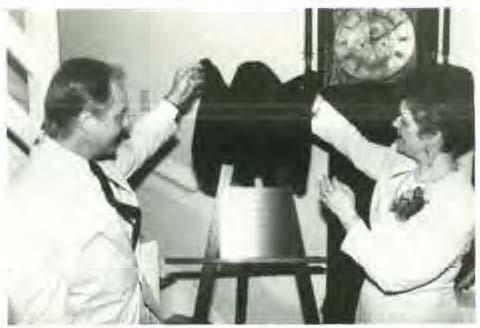
New Bolton Center, synonymous with superb veterinary care for large animals, provides a fitting backdrop for this fine collection assembled by Bruce J. Heim, a man devoted to animals and deeply committed to furthering the education of young people. Mr. Heim endowed the first two Dean's Scholarships at the Veterinary School.
The dedication was attended by Mrs. Barbara H. Pailet, executive director of the Bruce J. Heim Foundation, and board members Daniel Mullay,
IncludedinthisissueoftheBellwetherare thesummarizedresultsofan important economic impact study.As you willsee, tl1e Schoolof VeterinaryMedicinerepresentsfar more to the Commonwealth ofPennsylvania thananintellectual resource. Our y:dueto this greatStateandIts citizens canbequantitated JUJddefinedintermsthateveryoneunderstands -dollars.
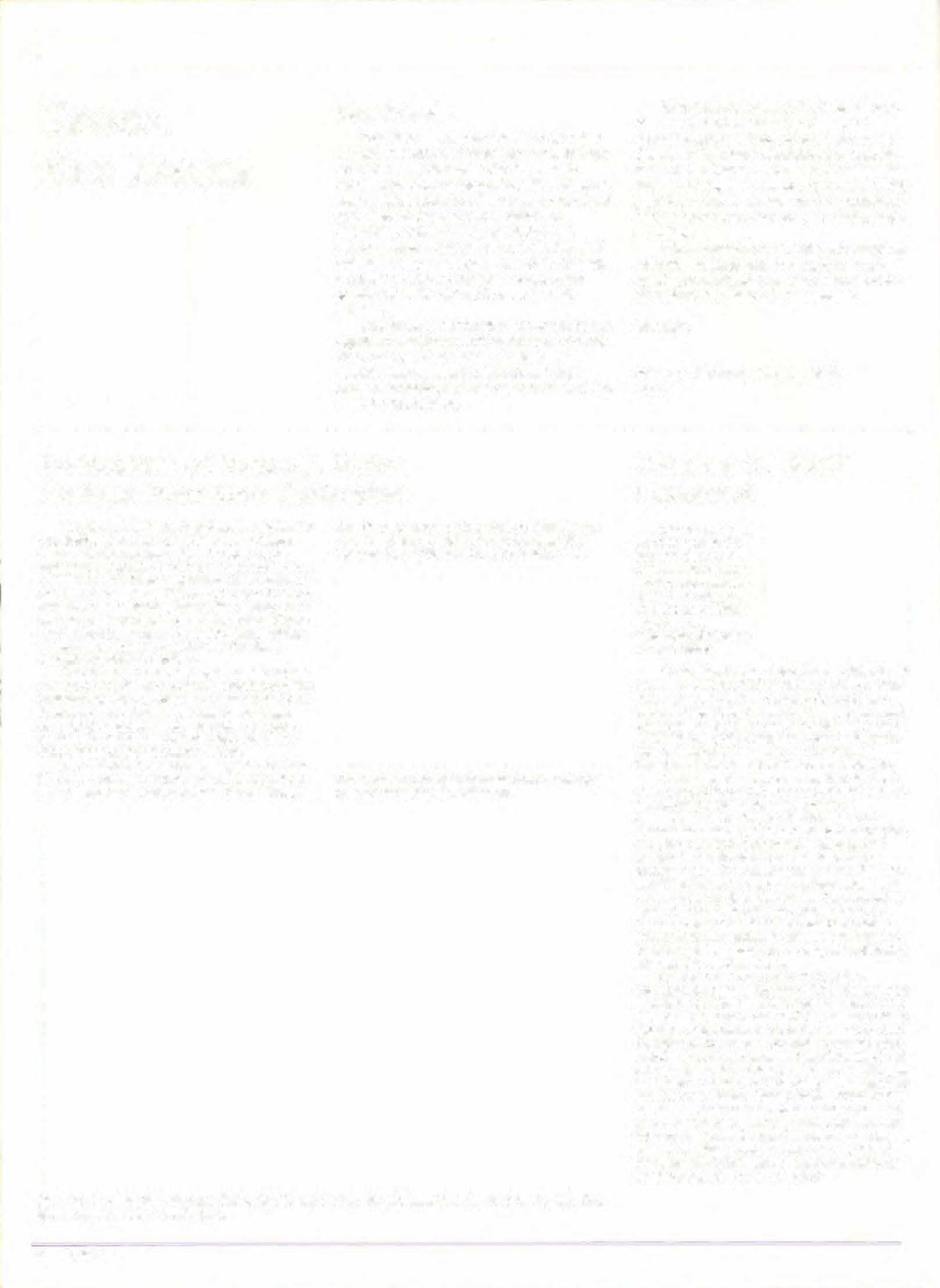
WeareproudofourintellectualstrengtiJin research,tescbing, andservice. butweare equallyproudofbeingastrongeconomicforce tl�roughouttheStste ofPennsylvania.
Sincerely,
Edwin J. Andrews, V.M.D., Ph.D. Dean
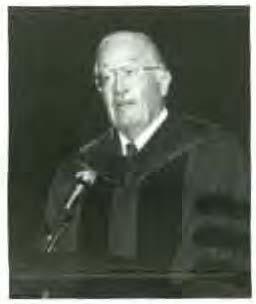
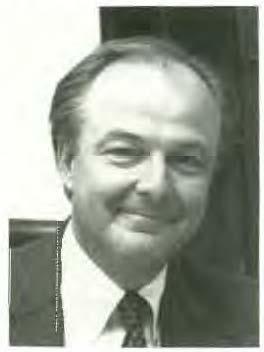
Charles S. Wolf Honored
Charles S. Wolf, the chairman of the School's Board of Overseers for 25 years a.nd a trustee emeritus of the University, was awarded an honorary degree by the University. Following is the citation:
"A double alumnus of the WhartonSchool, and a member of Penn's basketball team in your student days, you went forth to conquer the world as a successful industrialist and community leader, and cameborne to stay when you were elected aTrustee ofthe University ofPennsylvania over twenty years ago, and harnessed to serve as Chairman of Overseers of the School of Veterinary Medicine. Demanding of others no more than the hard work you put in yourself, you are an ideal boss as well as sought-after volunteer. Preferring involvement to standing on rhe sidelines, you nonetheless thinklong andhardbefore taking action, and your wise and inspirational leadership and analytical consideration have benefited tluee presidents as well as three deans at Penn. Believing that "free enterprise depends on free education," with a voice that is heeded on the Commonwealth front, you have brought your sage and courtly counsel to bearin theState, as at tl1e UniversHy of Pennsylvania. A pragmatic and successful man of business, you have long been an eloquent and heeded advocate for tbe liberal arts.
President and CEO of York Container Company, president of trustees of York College, past president and director of institutions in that Jocale from the orchestra to the YMCA, you are a fitting recipient of the Duke of York Award of the York Chamber of Commerce. Grateful to you for your spurring them to ever greater heights from the top of your particular hill - Mount Wolf - your colleagues and fellow Trustees at the University of Pennsylvania celebrate you, Charles Samuel Wolf, a friend trusted and true, and red and blue. Adding their acclaim for your magnanimous generosity with your time and treasure, they take pride and pleasure in presenting you, along with warmest wishes on a significant birthday, with their medaland their preferment, the honorary degree, Doctor of Laws."
Jim Cunningham and Tom Hutton. Also present were two .Bruce J. Heim Dean's Scholars, Dr. Barbara Vail, V'91 and Dr. Kirk Smith, V'91.
Dean Andrews and Mrs. Barbara Pailet unveiling the plaque ideneifying the collection.
2
From left to right: Mrs. Barbara Pallet, Mr. Daniel MuJJay, Dr. Barbara Vail, Dr. Kirk Smith, Mr. Tom Hutton and Mr. Jim Cunningham.
Bellwether
IMPACT STUDY: Exploring the Role of the University of Pennsylvania School of Veterinary Medicine
A study by KPMG Peat Marwick concludes that lhe University of Pennsylvania's School of Veterinary Medicine contributes more than$1 billion and nearly 2,000 jobs to the Commonwealth's economy.
These are the highlights of the study commissioned by theSchool as part of its long-range planning program. The study portrays the School as a major contributor to Pennsylvania's and the nation's agricultural and biomedical industries in three major areas:
• Manpower: through the training of highly qualified practitioners, specialists and biomedical scientists to meet present and future needs of the agriculture and biomedical industries; and through providing quality continuing education programs for practicing veterinarians.
• Economic development: by providing unique programs and outreach from the Center for Animal Health and Producrivity; and by delivering highly sophisticated veterinary medical services:
• Research/tecltnology transfer: by creating new knowledge through basic and applied biomedical research, including behavioral research, comparative medicine and public health.
KPMG Peat Marwick de$cribes the School as a recognized world leader, not only in veterinary medicine and education, but in the furtherance of biomedical research. [ts faculty are in demand as speakers at international conferences and their calibre is further recognized in the large number of endowed professorships at the School.
For more than a century, says the study, the School bas led the way in improving the health, productivity, and economics of food-producing animals.lt wasthe first to use tuberculin to control bovine disease; today, researchers are studying Johne's Disease and Salmonella enteritidis while others aredeveloping recombinant vaccines against a multitude of animal diseases.
Ongoing research promises future benefits in the fields of biotechnology and aquaculture and in the prevention and treatment of diseases potentially affecting about 80 millionAmericans and having an estimated market value of $70 billion annually.
"Such research breakthroughs will contribute to improved human health and preventionof disease," states the study.
The Commonwealth of Pennsylvania has historically recognized the importance of the VeterinarySchool to the agricultural industry in the State. It currently appropriates $15 million to support the teaching, research, diagnostic, and treatment acllv1ties of the School. This amounts to a third of the SchooJ's current operating budget, proportionately far less than stale support to landgrant veterinary schools across the nation which receive up lo 50 percent of their operating budgets from their states.
By almost any measure one chooses, the return on the State'sinvestment is enormous.Thefollowing is a detailed breakdown of the economic impact of the Veterinary School on Lhe economy of Pennsylvania.
The Veterinary School's Economic Impact on the Commonwealth
Total Impact
TheSchool's impact of more than $1 billion on the economy of Pennsylvania is both direct and indirect. The direct impact is the total dollar value of school-related expenditures in specific geographic areas; theindirect Impact is the additional spending and jobs created by lhe recycling of those original school-related expenditures in the economy.
Source
• School-related expenditures
• Teaching
• Research
• New Bolton Center Services
• Increased earningpowerofI.356 VMDs inPennsylvania.
• $94M Income impact
1.9t3 employment tmpact
• $ 42M impact •
• S714M impact #
• $ 158M impact +
Totai:$1,008M
II Annual loss of produc:tivicy due todiseases in food producing animals. (PDA Statistical Service; KPMG Analysis)
+Valueof roodanimal� and hors<s treated and returned to production and performance. (POA Statistical Service; TOBA: KPMG Analysis)
Direct Impact: The direct expenditures shown here are used to determine rhe income and employment impacl of the School.


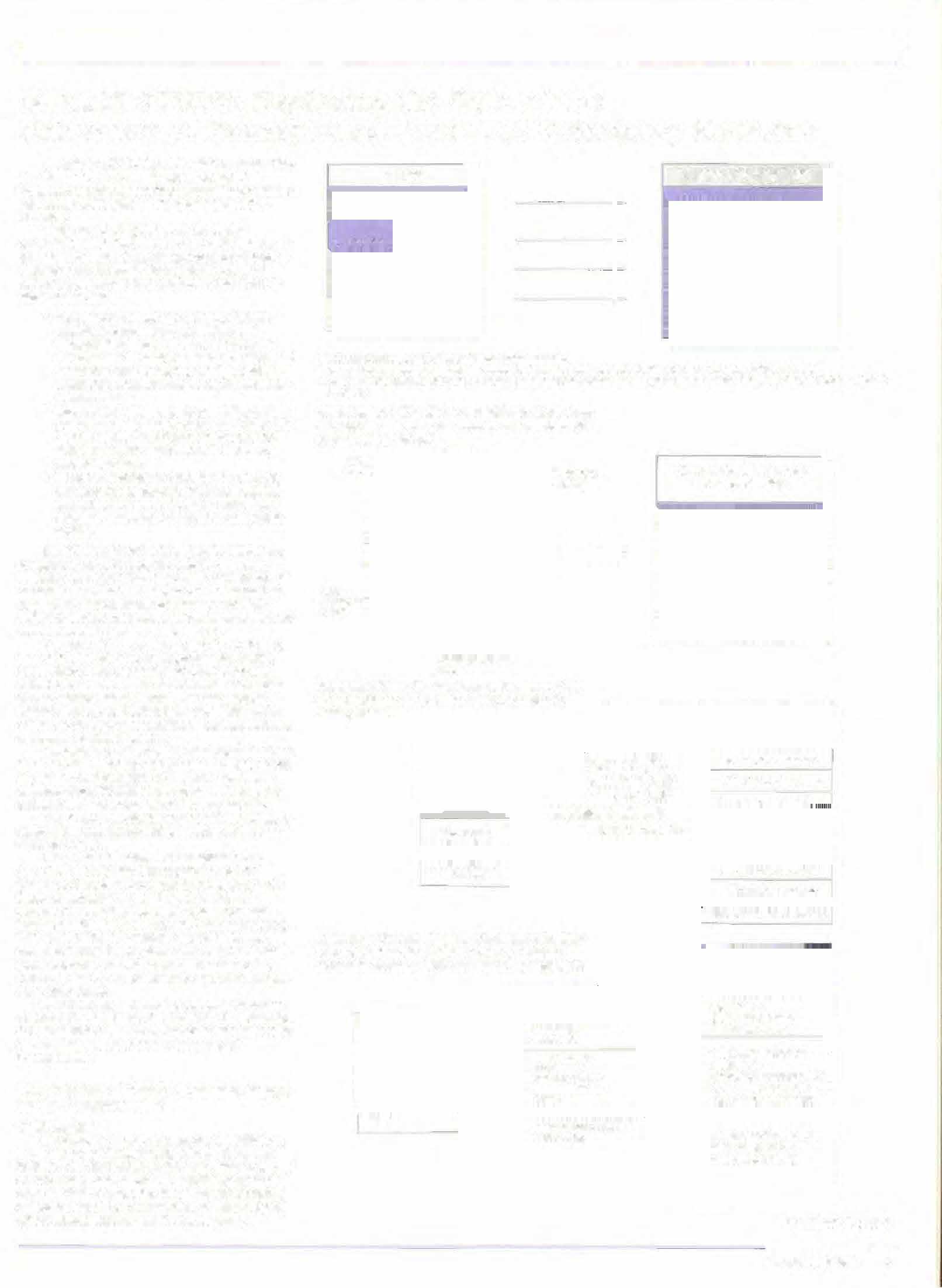
MultipUerEffect: The total economic impactofthe School-related expenditures is $93.6 million in Pennsylvania.

Multiplier Effect
TechnologyTransferImpact· The School'steaching . ' and service activities have a potential research econou1ic impact of $914 million in Pen11sylvania.
tm.,.c:tln
Pennsylvania
income impact
$136M Other Pennsylvania $7-tM
$119M Philadelphla S20.6M
Oilier
Adjacent" Counc�es
Cumuletlv•&pendltwesby GeographicRegion PhiladeiJ)hra $ 206M 5·County Area 32.5M Pennsylvama 39.9 M Total U.S. $53.5M mdlion Co n1y Incomellulttpller Philadelphia:1.7189 5·Cour1tyAres:2.2271 Pennsylvania:2.3491 UnitedStates:3.2591 sn4million'"5.C0untyArea $93.6mtlltoninPonnsvlvania 11742miiiOI\'"TotalUnited
$399mlfli0!1In Pennsylvama $53.5�lllllonInTotal UnlledSlaws EmploymenlMUltiplier"
s.mp.PotM1UII P!'Oducb Ac11vttlet • Prnc.ttioners • R&seardlers �eachrng � Foodproductbn • improvemems . Veterln8fYproduCis Research • Humanheatthcare prcxluds • Service • Treatmenlofvaluableammats • Foodproduclionefficiency � Improvements • 1olafEmplOymentImpact 14<103j0bs1n5·CountyArea 1913 2Jobslnf'9r>nsylvanl!l 3223.8jobsIn'TotalUnttedStales a.mplePow.nu.l knpeata Enhanced income and expenditures ($104miDionnUS: $A2miftionin PA) Food animal health and prowctlvity ($18bllfion potential in US; $714million potentialIn PA) New velennaryproducts ($14 m111ion potential'" US) New Bolton Centerservices ($239 million In US: $156 million inPA) (continued on page4) Sommer/Fall 1991 3
The Use of Animal Models Assists Researchers in Today's Scientific Discovery
The use of animalmodels in biomedical research is critical for continued progress to combat disease and to discover new and better treatments for e,,istiog illnessand conditions. The vast majority of scientists and researchers involved in medical exploration agree that without the use of animal models, major medical advances would not have been achieved nor would current research techniques be available.
To solve health problems,researchers must have sdentiiic data that is relevant to the hwnan condition. Data from humanexperiments is the most scientit1cally relative. But such experimentation, in many cases, is ethically unacceptable. Few people would offer themselves or a family member as the first subject of research to understand and cure diseases such as AlDS or Alzheimer's. The U.S.
Impact Study continuedfrompage3
Activity Impact: Food production research reduces farmers' losses and increases their output.
Activity:
FoodSupply
ProductivityResearch
Government requires that most safety testing be designed and based on results of animal experimentation and a knowledge of the history of the disease or condition under study. After humans, animals offer the most accurate means to assess human biological reactions and responses. Nonanimal research models are used in research labs across the country whenever possible. 'Biological models such as cell and tissue cultures, and nonbiological techniques such as mathematical and computer modeling, are used where appropriate. However, since these methods cannot mimic all the complicated interaction s that occur in humans or animals, animal testing is still necessary. Knowledge gained from animal research has helped scientists develop many adjunct techniques that are reducing the numbers of animals required.
ResearchProducts:
Preventionandtreatment ofdiseasesanddisorders impairingtheproductivity of thefood Industry
Additionally, the research into marine anjma1 medicine at Woods Hole, Massachusetts should have a significant impact on the growing aquaculture and
AcaivityImpact:Asaresult oftheSchool's teaching activities, its alumni increase their earning power.
Activit�·
Economic Impact
$17.7billionInlosses can beavoidedOf productivitygainedin the UnitedStatesagriculture industry($714.5million In Pennsylvania)
biotechnologyindustries inthe United States and in Pennsylvania.
TeachingProduct:
3.400livingVMDs able toeam an additional$30,692• peryear onaverage (�56VMDs In Pennsytvania)
Activity lmpact: The School's services offered through New Bolton Center treat over 24,700 large animals, reducing economic losses.
AC1ivily:
ServiceProducts:
Nearly8,700horses. 14,300cattleand1,700 othervaluableanimals treated
HealthCare
ServicestoLarge Animals
(future Potential Impact: The School is involved in activities which have not yet reSJtlced in specific, exporrable products. bur could potentially have a sigrujicant impact such as:
• Many sources expect the School to be an importanr contributor to the biotechnology industry and the aquaculture industry,among others.
Bellwether
The Role of Animals in Current Research and Testing
Biomedical research with animals has four major goals:
• To provide biological knowledge upon which disease prevention can be based;
• To provide models for the study of naturally occurring diseases of humans and animals;
• To testpotentialtherapies, diagnostic and surgical procedures, and medical devices;
• Tostudy the safety and efficacy ofnew drugsor to determine the potential toxicity ofchemicals to which animals will be exposed.
Researchers must understand the biology and physiology of higher organisms before they can make advances in thetreatmentand prevention ofdisease. Animal models provide jnformation on the mechanisms of disease and an organism's own defensive response. Scientists study animal models for clues as to how thedisease is transmitted and bow genetic susceptibility and other factors may predispose an individual to disease. In the case of infectious disease, scientists attempt to isolate the disease-causing agent in the affected animals as the first step toward development of avaccine.
Data fromanimal studies is essentialbeforenew therapeutic techniques and surgical procedures �n be tested on patients. Researchers must use animal models to develop and refine techniques to determine ir the techniques will achieve their purpose without risking harm to the patient. Animals are also essent1al to measure a d rug 's beneficial or harmful effects on organs and tissue. Moreover, data documenting efficacy and safety is required by the Food and Drug Administration (FDA) before a new drug is approved for testing in clinical trials on humans. Such testing remains the best predictor of adverse risks such as cancer, reproductive disorders and birth defects.
EconomicImpact:
Additional$104million expendedinthenational economyperyear,on average{$41.6minionin theCommonwealthof Pennsyivania)
Two of the most controversial tests are the Lethal Dose 50 (LD50) and Draize tests. The LD50 test provides data on how toxic a substance is by determining the dose needed to kill 50 percent of a test group of rodents. The classical LD50 test using large numbers of animals is rarely used today. The maximum tolerable dose is important information for some cancer chemotherapeutic agentswhere the clinically effective dose is near the lethal dose. The doses that animals tolerate on an acute basisprovide information for risk assessment and also determine dosesforfurther studies. Many toxicologists believe that fewer animals canbe used to achieve sufficient data, and work is beingdone to develop nonanimal methods.
EconomicImpact
Approximately$239.2 million inlossesavoided annually(approximately $157.6millionin Pennsylvania)
• The School's investigators are researching causes. prevention,and tre�tmenlfordiseases that could potentiallyaffect about 80million Americans.
• The estimated market for these treatments being researched is over $70billionannually. Such research breakthroughs will contribute to improved human health and prevention of disease.
There are two Draize tests:one for the eyeand one for the skin. The Draize eye irritancy test measures how safe a substance is to the eye by putting dropsof a substance on rabbits· eyes. While modifications of this test and alternatives are being explored, many scientists and the FDA believe that this isstilione of thebestpredictors of the effects a chemical would have on the human eye. The skintest is performed in a similar fashion. by exposing a chemical substance to an animal's skin to measure possible irritancy.
Duplication and Validation of Research
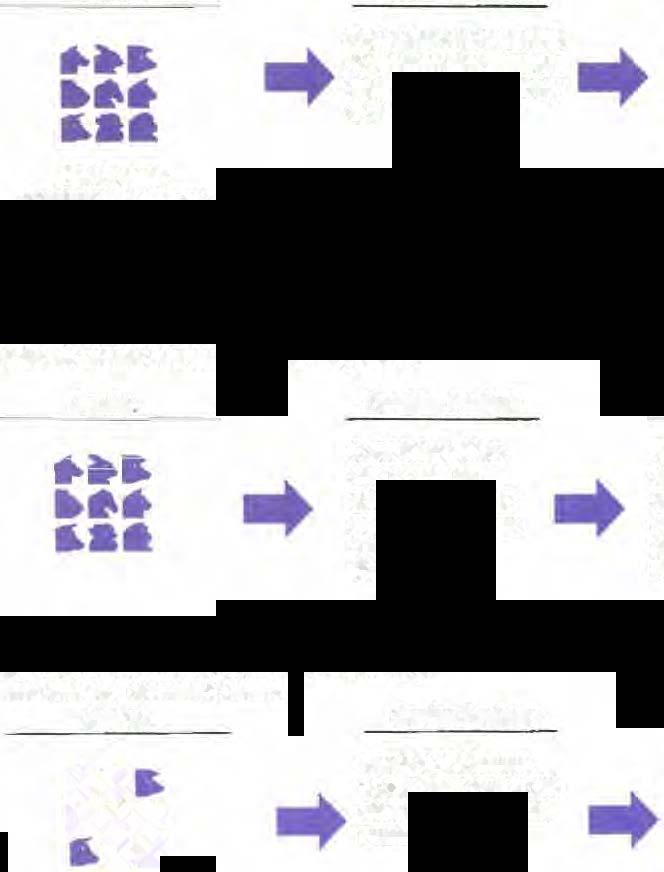
Both government and private research institutions practice stringentreviewprocesseswhen approving research projects because of concern for thenumber of animals used and because of the cost of research. Experts review research proposals to measure the importance of a project, its scientific merit, the competence and the appropriateness of research models.
Nlli, the major single source of funding for U.S. biomedical research, require!> each grant application to include abibliography of all relevant scientific literature to avoid unnecessary duplication of research. The cost ofresearch plays a significant role in deciding appropriate ventures. The NIH, for example.is able to fund only about one-third of all researcb proposals judged worrhy of support, and
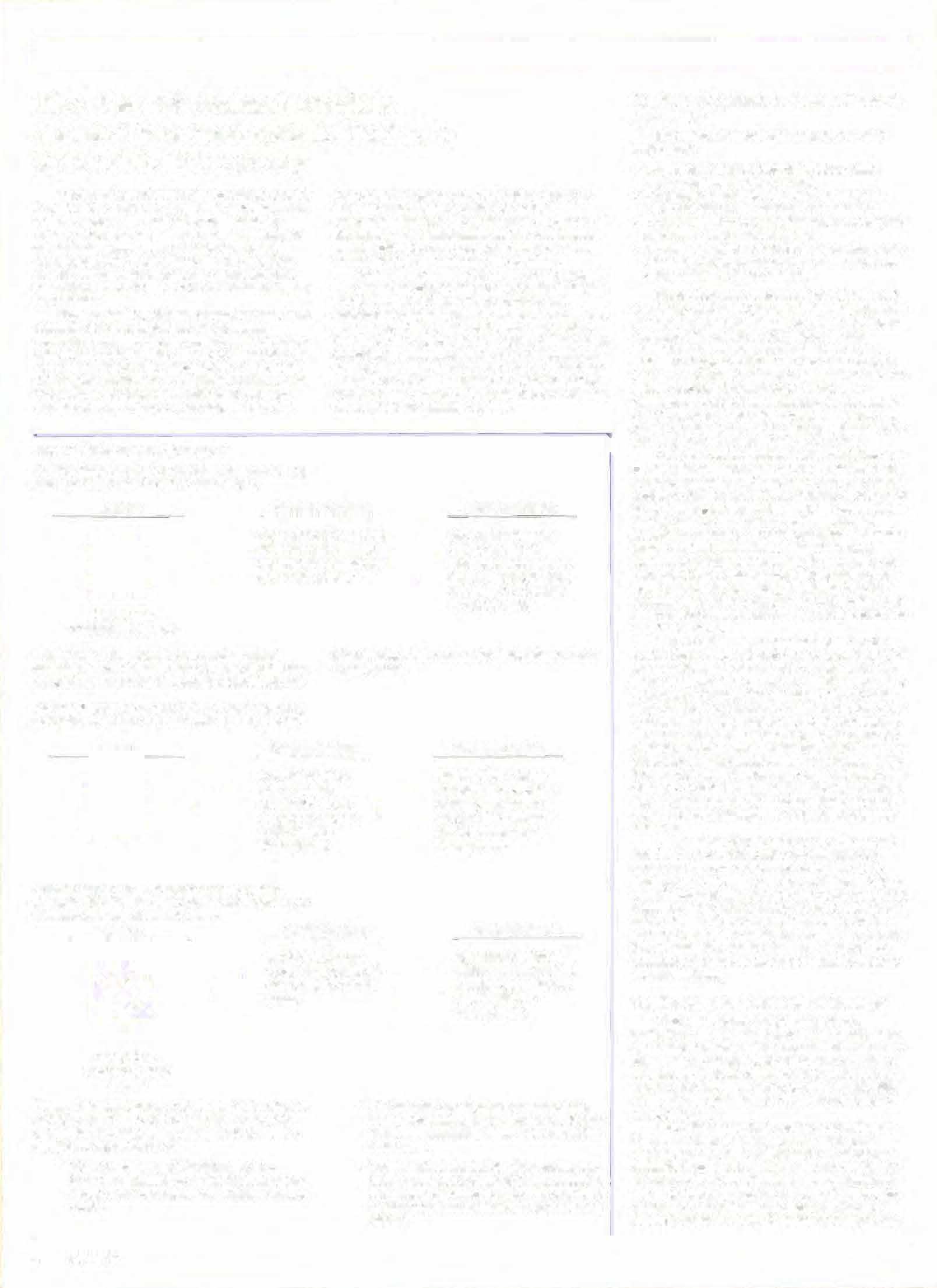
·� ••• ••
therefore, selects projects which will have the most impact on human and animal health. Similar research guidelinesare used at pharmaceutical companies and universities.
The Salk Institute in laJolla, CA. one of the world's premier research organizations. is one of many facilities with stringent research guidelines. The faciUty depends upon animal research for current work on AIDS, cancer and Alzheimer's disease. Accordjng to Or. Kenneth Klivington, assistant to the president at the institute, scientists must submit delailed research plans to the institute's animal welfare committee for project approvaL "lt is the responsibility of this committee to consider the validity of the argumc:ntfor the necessity of using animals, the number of animals needed, and whether 1he experimental procedures to be used, as welt as treatment beforeand arter the procedures, are in accordance with government guidelines and the. principles of humane treatment,'' he said. "Animals are never the first choice as subjects for research. Scientists at the institute use the most modern methodsavailable for biomedical research, and when possible conduct their research with the aid of computersimulations of biological systems and ceUs grown in laboratory cultures. But when there is absolutely no alternative way to answer important questions, scientists turn to research in animals."
Animals Used in Research
Rats. Mice and Other Rodents ... 8�% to90%
Dogs and Cats . .. I% to l.S%
Nonhuman Primates ... 0.5%
The r�:maining percentage includes smaU numbers of a variety of animal species.
(Source: Office of Technology Assessment Smdy"AiterMtivesto AnimalUse inResearch, Testittg andEducation.,')
The Use and Source of Animal Models
The Office of Technology Assessment estimates that between 17 and22 million animalsare used per year in biomedical research. The majority of these animals, approximately 85 to 90 percent, are rats, nuce and other rodents; lto 1.5 percent are dogs and cats; .S percent are nonhuman primates; and the rem.Uning percentage includes rabbits, birds, and domestic and wild animals.
According to the Institute of Laboratory Animal Resources survey, there was a 40% decrease in the number of animals used in research between 1968 and 1978, wilh the Jargest decline occurring with nonhuman primates, dogs, cats, and birds.
The reasons for this decrease are complex and include the refinement of research techniques, development of alternatives and a decrease in research funding. Funds for research have f.Uied to increase at the same rate as costs of acquiring and caring forlaboratoryanimals. Researchers have also lowered the incidence of spontaneous diseaseamong labanimals. Today the sameresearch objectivescan be obtained with feweranimals because of improved methods for breeding, rearing, genetic control and environmental design.
The overwhelming majority of lab animals are rats and mice bred for this purpose by licensed suppliers. Large animals, such as swine, cattle, and sheep,are supplied primarily by agricultural sources. Most nonhuman primates used in research come from scientific breeding centers, not from the wild.
Many cats and dogs necessary for research are bred for this purpose and others have been abandoned in public pounds and animal shelters. Estimates vary widely, but of Ihe approximately 16.2 to 27 million catsand dogs left in pounds and shelters each year, only about 1.1 percent (approximately 138,000 dogs and 50,000 cats) are used in research annually. The majority of these pound animals, between 10. 1 and 16.7 miJlion dogs and cats, are put to death by animal care and control agencies each
year, according to the American Humane Association's 1989 statistics. The remaining animals are claimed by their owners or adopted.
While the majority of lab animals are rodents, other species are used in small numbers to provide data aot fully available by using rodents. The dog model. for example, continues to assist scientists in discoveringnew therapies for cardiovascular disease, and in the evaJuation of new drugs and surgical techniques. Nonhuman primates, also used in small numbers, help scientists investigate reproductive disorders, hepatitis, deafness, head injuries, and eye disorders in chiJdren. Other examples of today's research include the use of mice to studyimmunology and calves to belp improve the performance of artificial heart valves.
''Current laws administered by the FDA do not specify the use of animal testing," said Dr. John Augsburg, assistant to the director of the Center for Veterinary Medicine at the FDA. ''However, the FDA position is that the use of animal tests by industry to establish the safety of regulated products is ne�ssary to minimize the risks from such products to humans and animals. Consideration should be given10 the use of validated and accepted alternative methods of animal testing. However, many procedures intended to replace animal tests are still in various states of development and it would be unwise for the FDA to urge manufacturers not to do any further animal testing. There appears to be (jttle chance of much replacement of animal t esting in the foreseeable future."
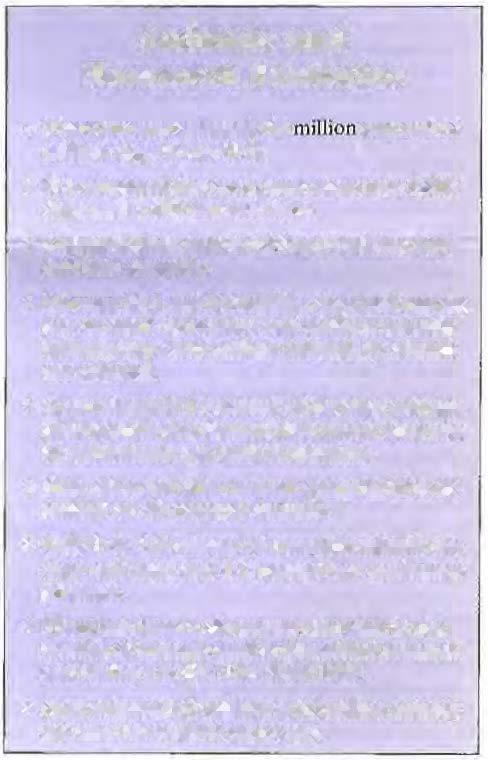

Care of Lab Animals- Laws and Regulations
The care of lab animals in universities, medical schools, hospitals, pharmaceutical companies and other research facilities is monitored by the U.S. Department of Agriculture (USDA), under the provisions of tbe Animal Welfare Act (AWA). The AWA has been amended three times since its passage in 1966. USDA officials make periodic unannounced inspections to ensure compliance with stringent standards for housing, feeding and watering, cleanliness, ventilation and veterinary medical care.
The U.S. Public Health Service (PHS) has an Animal Welfare Policy that applies to all NIHfunded projectsinvolvinganimals. The NIH requires that the institutions follow the Guide for the CaTe and Use of Laboratory Animals, prepared by the institute for laboratory Animal Resources of the National Research Council. The organization also serves as a scientific forum for laboratory animal medicine and care.
The American Association for the Accreditation of Laboratory Animal Care (AAALAC) offers a lab accreditation program. In addition, the FDA and the Environmental Protection Agency (EPA) have Good Laboratory Practices regulations (GPLs).
The AWA calls for the use of anesthetics and analgesics for potentially painful procedures and for postoperative care. These regulations, along with animal care regulations within each faciJity, en..<mre thatanimals receive thebest care and the least pain and distress. USDA statistics stae that approxlmately 95 percent of all Jab animals in federally protected facilities are not exposed to pain or distress. Of the remaining percentage, many animals are involved in studies of pain itself, and pain-relieving drugs or anesthetics are administered as soon as possible during the study.
Dr. M.H. Cook, of the USDA's Animal Plant Health lnspection Service (APHIS), said most of the 1,100 USDA-regulated research facilities consistently comply with federal standards. and have often initiated improvements foranimal care called for in the AWA amendments before theyhave become law. APHrS inspectors follow strict guidelines to ensure air temperature, housing and feeding areas, and other regulations are met. "We find that, in general, the scientific community does a good job and is concerned about the care of lab animals,'' Dr. Cook said.
The most recent amendments to the AWA address animal care and use committee oversight of animal programs. Research facilities have established animal care committees to review laboratory animal care and use issues, including the researchers' consideration of alternatives and the appropriate animal welfare aspects of research procedures. This concept has been a long-standing prerequisite by AAALAC for accreditation.
AAALAC, formed in 1965 and based in Bethesda, MD, is an independent, non-profit organization which offers a peer review accreditation program for research faciliLies. Dr. Gene New, executive director of the organization, said the 540 facilities accredited by AAALAC point to the concern the biomedical community has for maintaining quality animal care and use.
Tbe AAALAC peer review program is an effective quality control measure, he said. "Accreditation also conveys a 'Gold SLandard,' an important criterion for credibility with the public-atlarge. The highly regarded AAALAC Accreditation Program is voluntary, but has tee1h. It is AAALAC's intent to work with institutions to improve and maintain quality animal programs. However, organizations that do not conform with AAAlAC criteria are denied accreditation, allowed to withdraw. or revoked from AAALAC accreditation. Less than I percent of the programs evaluated by AAALAC fall into this category."
Animals and Research Statistics
• There are approximately56 million c�ts am154 milliOtl dogs in the U.S.
• (l is e�timated that every hour more than 2,000 dogs and 3,500 cats are born

• Animal shelrers take in I6 2to 27 milliondogs and cats annually.
• B�tween 10.I and !6.7 million dogs andcatsare put to death in pounds and shelters annually because they were neither claimed by owners nor adopted.
• Approximately 1.1 percent of the dogs and cats from pounds and shelters, that would othermse be euthanized, are used in research.
• Rats, mice and other rodentscomprise S5 to 90 percent of all research an1mals.
• Only 1 lo 1.5 percent of research animals are dogs and cats; and OS pttcent are nonhuman primates
• l'bere bas been a 4() percent decrease in the number ofanimals used in biomedical research and c.escing in the U.S. since !968.
• Approximately 17 millio11 to 22 mUlion animals are used in research each year.
(Sources: The American Humane Association, USDA, Foundation for Biomedical Research, Newsweek)
"The Three R's" and Trends inAlternatives
Most research organizations and scientists are following a practice known as the "Three R's," which stands for replacement, reduction and refinement.
Replacement refers to the use of nonanimal techniques instead of animal models or a lower species of animal when possible. For example. rabbits are no longer used for pregnancy testing, and some preliminary drug toxicity testing can be done using cell cultures, rather than animal species.
Reduction refers to areas where the number of animals used can be reduced. The number of animals used in acute toxicity testing is being reduced as scientists have discovered ways to obtain accurate toxicity data using fewer animals. In addition, (continuedonpage9)
Summer/Falt1991 5
�
.1�
i dips �hould be avoided.
l Flea-fighting products corne in many forms.
Spraysmaybewat.,orllcobolbaoed. Water·based spraysarele!>�expensiveandkiUtbe fleas ataslower
rate.Alcohol-b�t:.cd �praysdry qujcldyand kiU neas
FeltneFanC1erS
• brusherre which can � filled with the liquid. h is
SYmpoSturn
The 14th Annual Feline Fanciers Symposium was held April 13, 1991 at VHUP. Following are summaries or the three presentations.


Feline Reaction Patterns
Dr. Karen Kuhl, a resident in dermatology, discussed felineskindi1>ordcrsand how LbesevaTious diseaseb are manifested by different skin reaction patterns. Or Kuhl l)lated while manydisordershave specificpauem� and can beidentified fairlyeasily. n is not enough 10 make thediagnosis and treat the anlm;�l to relieve discomfort; the veterinarian must look funher todeterminethe underlying cause ofthe skin disease to prevent its recurrence.
The most common skin disorder in cats is eosinophilic granuloma complex which is divided into three group�: indolent ulcer (rodent ulcer, eosinophilic ulcer); eosinoJ'Ihilic plaque; nnd linear granuloma.
The indolent ulc:er appeats as a red ulcerative lesion on the upper lip. In mauy cas¢s the area involved may be small and the animal may not be botheredby it. However,the lesion can becomevery uJcerated andinvasive, then h need� tobebiopsied to rule out squamour, (•ell carcinoma. Most indolent ulcers are due to allergies, cither to neas. food, or inhalants.There IS evidc:ncethatsomecats mayhave an inherited predlsposirion to the disease
Eosinophilic plaque manifests itself by red, raised, ulcerated lesions on the abdomen, inner thighs,or under thetall. Thecal itches andexi'Libits exce3Sive grooming behavior. ln most cases the disease ts due to allergit!S� however, deep fungal infections and neoplasia need also be considered in thec;e ens�. Therefore, depending on the: history, biopsie" for histopathological examination may be warranted.
Line.ar granuloma caus� raised yellowish-red

Unear. trchylesions. mo'it commonlyon theback of the rear legs. This is a collagenolytic granuloma which also is sometimes lower lip swelling and a �wolleu chin. It is most oftt:n caused by allergies.
Some cats can have more Lhan one form of eosinophilic granuloma Gt !hesametime. For many years.theselesions weretreated\\ith steroids without looking for the cause. Now veterinarians can per· form appropriatete�ting.di�ccm which allergy is the •tto�1 1ikely cause,and savethe cat from a lifetime o( steroid usc.
Felinemil1a.ty d�rmatitis.anotherC'ommon skin disorder.generally consists of multiple, stnall (milia� ry) crusts and pnpules (red, raised bumps) on tbe bad, but occasionally extending to the ned, and head.Titeselesionr.U)ually itch. Thecomplel(iseasy to diagnose, but the most difficult problem is to determine the underlyingcausewhich t:an beallergies to fleas, food.orInhalants (most common); bacterial Infection, fungnl infection,micc::sand other ectopara· sites, drug reactioru, autoimmune di!lease, and unl.nown causes. Or. Kuhl wes:.ed that appropriate diagnosticsshould beperformedtoavoid havingto treat the c.n1 with stc!roids for the rest of its life.
There arc a number of other skm diseases. Allergies, ringworm. clemod<"X , nnd rarely.psychogeniccau�es, aretheculpm.; in "bald bellysyndrome" where the cat excec;sivety grooms its

abdomen, destroying rhe halrcoat. If lhe cat has a bare belly with no hair stubble, it may have feline endocrineatopeda.a hormonal disorder. Bald belly syndrome is seenmore frequently in Abyssiniansand Siamese and may b\! due to psychogenic causes in these brl!ed!; a� they are qulte high strung.
Facialt.lcrmatuis can often bequiteunsighLI}'as the cat scratches <xcessively at its head and neck, crealing lesions that are ulcerated and encrusted. This disorder is often the result of food allergies, however, ear miles. nea or inhalant aUergies, nototdricmange, autoimmunedisease, and demodex mayalso� underlying causes. Ahistorywillgive the veterinarian a.;lue; if the animalshows crusting finn, then the roost likelycause is autoimmunedisease;if the animal scratched and then crusts appeared� the cause is most Likely allergic. The problem generally begins around the eyes and in front of the ears.
When trying to determine the underlying cause ofslon problems. the veLerinarian need� 1heowner's help.Athoroullh historyisvitaland LO elicit it, many que�tjons will be asked: has if b�n a seasonal problem ·thiswouldIndicatefleaorinhalant allergy� areany otberanimals inthehousehold affected-this would indicate ear mites. flea allergy, or notoedric mange; did 1he lesions comefirst or clid rhehchcome first: where on the body did rhe problem manifest 1t�elf fir�ot: what previous rnt:dicarions were used in Lhe eat's treatment and how clid it respond?
Dr. Kuhl then discussed a number ofdiagnostic procedures available. Sltin scrapings are needed to look for demode.x mites, notoedres or cbeyleti.ella. Fungal culturesarenecessaryto diagnose ringworm. Blood tests are needed to determine the animal's general health. Feline leukemia and feline immunodeficiency status should be determined as these two disorders may make the animal more susceptible to skin di!iordcr�o. lf a food allergy is suspected.then a food dimination diet may betried to identif)• the offending food component. To determine whether the cat is aJiergic to certain inhalant substances, mtradermal allergyce�1ing can be performed. Skin biopsies for histopathologic exammalion are another diagnostic tool.
Once theundrrlyingcauseof the skin condition has been found it can be treated. By Car Lbe most common ca\tse ofallergy is a flea bile allergy. Hereit becomes importaDI Io nor only 1reat thecatbul also its erwironment. Or. I<uhl stressed that fleas spend very li11letime on tbe cat and most oftheirtimein the room in cracks. under the furniture. In tht: carpet, etc. Beenus� cats groom themselves frequently, evidence of fleas i� rarely found on the animal.
Dr. Kuhl discussed a num�r ol'chemicalsused for flea controland <;tressed that cats are ver scn.�itive.Thus it is important ro read the belsand check the Ingredients. Pyrethrins and pyrethroids (e.g. permcthrin.tetramcthrin,allethrin, rcsmet.hrin) areul!utllly quitesafe. Thesechemicals killfleasand repel them, though theylo�oeeffectiveness in about 48 houn. Some sprays conhun piperonyl buto.xide. a synergist which works withthepyretnrinsto killfleas more effectively. It con be tox:ic to cats at levels of greater than 1.5%. lt al-;o may cause drooling at lower levels. Another synergist. N-octyl bicycloheptenedicarboximide,hasa lower inddence of side effects and IS often used with piperonyl butoxldc so that a lowerconcenrration ofpiperooyJ butoxide rnay be used. Organophosphates should be avoided. There hM bcc:n u report of neurologic problems developing nl'ter a cat was dipped with a dJp containing d-1imonene. therefore citrus extract
quid.ly. hutshou!d be avoided if1 be cal hasan open wound. AJso, arumaJs must be kept awn)' from an open name. Becausecatsdo not liketo be sprayed, Dr. KubJ recommended that owners purchase a then brushed into the hair coat. She also cautioned
1bat nursing kittens shouJ() not be completely
sprayed.onlysmaJJ nrnounts ofthechemicalshould be dabbed on their backs. Organophosphates or carbamates should not be used on kittens, only pyrethrinsor pyrethrolds.
Flea dips tend to be more toxic than sprays, especinlly forcat\.Shampooskill neasbuthaveno restdualeffect!'>. Oust,aueavery �fcmethodforflea control, bul arc not ac; easy or cosmetically appealing. Or. Kuhl strongly recommended against the us:c of SY!iletmc�. which are usually organophosphatesand which are not licensed foruse m cals.
Themost important partofcombatting flr:.as is tr�rment ortheenvironment.Theroom,carpeting, and furniture have to bt: thoroughly vacuumed. Beddjng need�10 bewashedanddriedon ahigh heat selling.Thenthe areashould �sprayed. even under thefurniture.Floorsshould �allowed todry before the animal comes back into lhe room.
lnbolant allergy is treatcc.l with a vaccine that hyposensitizes the animal. These injeL."tions can be given at home.

Ringworm ishlghJycontagou!>andaU catsinthe household must be treated.even iftheydonotshow signsofthedisease. Treatment imolves lopicaldip� and/or oral antifungals. AU cats should be completely clipped before dipping, including the whiskers. This decreases the mk of contaminating the environment and recontaminating the cat. The dips vary greatlyin their protocols and may beu.'>ed once or Lwit:e weekly. The oral antifuogals require close monitoring by the veterinarian. One of these cannot be used in pregnant queen�a�it causes birth defects. The environment must be thoroughly vacuumed and all bedding, brushes, combs and the like must be destroyed. Heating and cooling vents shouldbrcleanedanddisinfected. Kittensshouldnot be sold until two negative fungaJ cultures are obtained.
Pet Loss: Losing a Member ofthe FamiJy - What it is all About
In 1977 the University of Pennsylvania School of Veterinary Medicine entered into a joinL project with the University's Graduate School of Social Work. After acarefulevaluation or the need� of tbe ho11pitaJ, a full-time sociaJ worker was hired to coun�elclientswhosepetswereseriously iUordying. The Idea of having �omeone work wi1h and be available to upse( pet owner� originated at rhe UniverS-ityorPenn�ylvaniaVeterinarySchool.Since then. theconcept ofpet bereavement counselinghas spread to other veu:rinory schools and clinics.
Kathleen Dunn, M.S.W .• the current full-time �oclal worker a1 tht: Veterinary Hospital of the Unio;ersity or P�nnsylvania (VHUP). discussed pel loss. ''Pets provideunconditional love.They take on many roles ill a person's life. they C'Bn be a companion, abuddy, a be!>t friend, a child. asjsteror brother.A pelisalwaysthereto loveusand greet us. Whenastronganachmentformsbetween theowner and the animal, the pet becom(.'s a person anda pan of tbe famt1y.''
People want lhc Ionge�' possible liFe for their pets; in fact,wewould love our p<:tsto live forever. Often, when an animal is brought to VHUP. it ib because it has Ufe·threalenJngdisease. Ms. Dunn is
4
1thAnnual
e •
1.
6 �llwetber
available, with the veterinarian, to help the upset owner at this very stressful time. •• It is verydifficult for the attached pet-owner to make a decision if euthanasia is recommended because the animal's quality of life is poor," she said. "Because of attachment and bonding to the animal most owners feeJ very guilty The sentence r hear over and over is: ·t feel as though1 am putting a member of my family to sleep. lntellectually 1 know the animal is suffering, but emotionally this is very difficult to do.' " It is here that the role of the veterinarian becomes very impor1ant. He or she has to understand the emotional pain the owner is suffering at this time and has to understand the pet owner's concerns. Ms. Du1111 explained that owners cope in different ways with euthanasia of the pet. Some take the animal home and have their veterinarian come to thehouse, feeling it least stressful on the animal. Some havethe animal euthanized here at VHUP - wanting the vet who took care ofit to do it, and often owners wantto be with their pet and hold it while the drug is injected. saying 'my pet has always been there for me. 1 can't leave it at a time like this.' ''We try to accommodate the client and the pet as much as possible," she said, ''we respect the relationship the owner has had with the pet.''
Ms. Dunn explained that in theowner's grieving process the disposition of the pet's body is an important issue. "There are several opLions: owners can take the body back to bury on their property, or they can have the animal interned in a pet cemetery, or VHUP can arrange for individual cremation where the ashes will be returned to the owner. The cremation is performed by an outsidecrematorium We can also arrange for communal cremation, but thenno ashes wiU be returned.'' Each pet owner feels differently, and individual wishes are an important consideration.
Ms. Dunn said that itis vital to the owner to be able to talk about the petand the disposition of the body. "People wiiJ tell me that they want the ashes because they feel they can still talk to their animal. Others want the ashes be buried with them, and this can be arranged withtheir family. Others will scatter the ashes in a park or at the pet's favorite play area."
All this is part ofthe grieving process. Ms. Dunn explained the phases of grieving, such as anger and guilt. "People are often angry at themselve-S, they feel that they may not have taken the animal to the velearly enough, for example." she said. "They may aJso be angry at the surviving animals. People can be very irrational for the first 24 hours after a pet's death and it is important that they express their feelings; they will be calmer after the outburst.'' When a beloved pet dies, people go through a mourning and grieving process and are often surprised at the emotional reaction they arc havinge.g. crying, sadness, and depression.
Guill is another emotion that surfaces early in the grieving process. "People will ponder whether they were responsible for the ilJness or death because they forgot to give medication once or twice, or be<:ause they ignored some minor instructions from the vet," she said. "I try to tell the students that owners may call repeatedly after a pet's death asking
the veterinarian questions as to whether they were indirectly responsible. This is very important and the veterinarian must be understanding." Most oftenthe calls come from very responsible owners who are feeling guilty and need reassurance they did everything possiblefor their deceased pet. The stress people are experiencing can be very intense. Grief affects people differently. Some may not be able to eat, others may overeat; sleep may be fitful. Most peoplecry and are surprised at thedepth oftheir sadness and depression "Wecounsel people to resume their activitiesas quickly as possible and to stay busy.'' Above all, it is very important that people talk about their loss, either with their family and friends, or, if that is not possible, with Ms. Dunn and the Pet Loss Support Group at VHUP. "We meet twice a month and help each other to work through the grief," Ms. Dunn said. "Often grieving fora pet stirs up memories of a previous loss, mostly of beloved human relatives, and it is important to taJk about it at tbis difficult time." Again. people are surprised to find themselves thinking of a beloved relative who died, maybe ofthe same diagnoss as the pet or another serious illness. People can cometo the grief support group as long as they feel the need. Quite often private vets refer specific clients, or people call who have read about the group. Ms. Dunn emphasized that it is importanl to work through the grieving process without delay because it will speed up recovery. "The sadness will never totally go away. but it will be easier to cope with." She also offered some tips about dealing with the loss. "Some people keep a log of their thoughts about the pet; others write letters to Iheir pets; others write poems, or paint a picture, or prepare a photo album. Talking about the pet and keeping busy are important All this helps to come to grips with the loss."
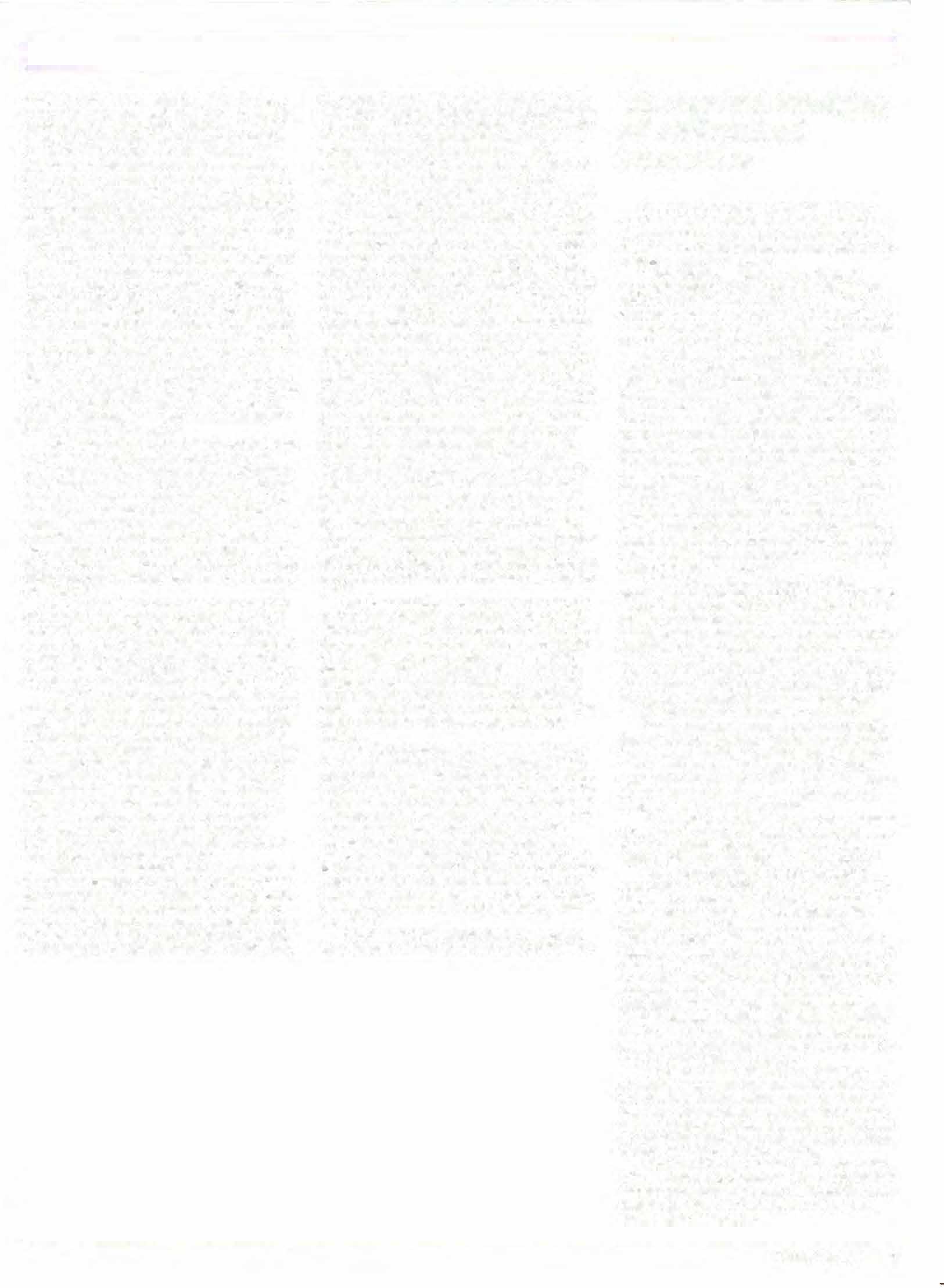
Ms. Dunn mentioned that some owners are able to overcome the grief by obtaining a new animal, while others are not able to replace the pet because theycannot face the thought ofeventual loss of that animal. However, as time goes on -most of this group can't stand the silence in their house and eventually obtain another animal - they miss the companionship of a pet. "It is a very individual decision and each one has to work it through." What might be right for one owner, might not help another.
Ms. Dunn touched briefly at her role here at VHUP and mentioned that she is part of a team, though not giving veterinary advice. She is also an important resource and support for the fourth-year students who, for tbe first time, come face to face 'vith clienlS wicb terminally ill animals. "We teach our students, interns, and residents about rhe importance of the pet - owner attachment and bonding. We teach about the grief process and what theveterinarian can do to help the client which is very important in all this. We are available for students, interns and residents when they need helpin working with upset petowners whose animalsare ill or who have died.''
Ms. Dunn is also available for pet owners who have lo� a pet. She can be reached at (215)898-4529.

Ultrasound Imaging of Abdominal Disorders
Ultrasound. a relatively new technology in veterinary medicine. is a valuable diagnostic tool for the examination of soft tissues and organs in the abdomen. Dr. Mark Saunders. assistant professor of radiology, gave an overview.
11Abdominal ultrasound is an additional diagnostic modality available to the veterinarian, said Or. Saunders. "It is often used to clarify an abnormality seen on a radiograph. In addition, we can use ultrasound to biopsy or aspiratea mass as we can guide the needle to an exact location."
lt is a form of non-invasive: imaging. Sound waves above the frequency limits of human bearing, ranging from 2 to 10 Megahertz, are emitted from a transducer placed on the skin. These varying amounls and strength of sound waves are reflected back to the transducer from different tissue and an image is generated and displayed on a screen. The ultrasound waves emitted from the transducer into the tissue gradualJy lose their SLCength with depth of penetration. The amount of sound absorption is directly proportional to the frequency of lhesou.nd. High frequency sound, because of higher tissue absorption, cannot penetrate as deeply into tissue. For this reason, high frequency ultrasound is used to examinesuperficial structures, and lower frequencies must be used for scanning deeper tissue. Ultrasound cannot penetrate bone or air.
VHUP's ultrasound equipment is quite sophisticated and provides detailed Jmages. The ultrasonographer has available a selection of transducers emitting varying frequencies; the image can be frozen. il can be measured and calculations can be performed by the built-in computer and everything can be recorded on tape. The images are thin cross-sectionaJ representations of anatomy taken in various planes. By imaging the internal architecture of organs, ultrasound differs from radiographs which depict only the silhouette of an organ.
For an ultrasound exam the animal generally does not have to be sedated. "Animals nre placed on their side on the table," explained Dr. Saunders. ·'The abdomen bas been clipped to allow better contact with the transducer. To enhance this contact, a gel is rubbed on the skin. Most animals relaxand some go to sleep during the exam.
"A complete ultrasound exam of the abdomen takes aboul 30 minutes. We don't just zero in on one organ but examine the entire abdomen. Often abnormalities are found that no one suspected."
Each organ presents a specific ultrasound appearance and the radiologist is able to diagnose disorders in the organ by changes in the amountof sound retlected, depending on the <.Hsease. For example, a heaJthy liver has a certain echogenicity(reflectivity), if the liver bas a lot of fatty tissue, the echogenkity changes. "ln a majority of cases. 1he ultrasonograpbic abnormalities seen in an organ are not specific for a certain disease," said Dr. Saunders. "But when these abnormalities are integrated with the history, physical examination findings, radiographic abnormaJities and laboratory results we can be more specific about the disease process. In some cases biopsy of the organ or mass is needed for a definitive diagnosis.''
Structural abnormalities of the following abdominal organs can be evaluated by ultrasound: liver and gall bladder, spleen, pancreas, stomach, intestines, kidneys, bladder, prostrate gland, uterus, testes, adrenal glands and major blood vessels. These structural abnormalities may be caused by infection, tumors, cysts or obstructive processes.
Ultrasound is also used to examine the heart. VHUP's cardiology department has a sophisticated Doppler echocardiography unit which provides color images and allows for a detaHed, non-invasive examination of the organ.
Summer/Fall 1991 7
Treatment of Canine Osteosarcoma
Each year about 10,000 dogs in the United States, mostly of the large and giant breeds, are diagnosed with osteosarcoma (OSA), a painful bone tumor. This disease also occurs in humans, though not in such high numbers. Osteosarcoma in dogs affects primarily the long bones of the leg, but can affect bones of the spine, skull, or ribs.
"Over the last ten years there havebeen major advances in treatment of this disease in both species.'' said Dr. M. Joy Weinstein, assistant professorof surgery at Peon's School of Veterinary Medicine, ''but better treatment protocols are still needed. Therapy for osteosarcoma of long bones includes amputation with or without chemotherapy, or limb-sparing surgery and chemotherapy. Limbsparing surgery involves removal of the primary tumor while preserving the limb through use of a bone graft or a prosthesis. Twochemotherapy drugs that appear to be most effective in this disease are adriamycin and cisplatin. Unfortunately, at this point in time, we cannot cure the disease, but we can give the dog a good quality of life for a number of months or years."
Dr. Weinstein, who returned to Penn after surgicalspecialty trainingat Tufts University School of Veterinary Medicine, is conducting a study assessing perioperative and postoperative treatment of OSA by administering adriamycin and cisplatin concurrently. ''These drugs usually areused alone or alternated to reduce the growth of metastases. By administering them together we hope to achieve an. additive effect."
Osteosarcoma in dogs frequently manifests itself as a limp; the dog is in pain and often refuses to use Ihe leg. Radiographs reveal a bone LUmor at the end of the long bone of the leg, either front or rear. '·When the animal comes to the veterinarian, the tumor has already spread through mkroscopic lesions to other parts of the body, primarily the lung," said Dr. Weinstein. "If we amputate rhe leg and give no other treatment, the median survivaltime is about 18 weeks, though some dogs (10 percent) live more than a year. Jf the animal is treated with chemotherapy, either cisplati n or adriamycin, the median survival time increases to about 40-45 weeks, with nearly 50% of the dogs living more than a year."
Amputation of the affected limb is Dr. Weinstein's preferred surgical treatment "It relieves the pain and the dog can get around quite well on three legs," she explained. ''Most dogs walk one day after surgery and need exercise restrictions for only about LWO weeks." An alternative to amputation is limb sparing surgery. She recommends this treatment for dogs that would not get around well on threelegs or those cases where an owner cannot accept amputation as an option for the dog. Here the tumor and the affected section of bone are removed� and a bone graft is used to replace the missing bone. The graft can be donor bonewhich hasbeeu frozen and stored, but infections are common with this method. Dr. Mark Cofoneand Dr. David Diefenderfer have used autogenous, cancellous bone as the graft. Small amounts of the soft bone from the marrow cavity of the dog's own shoulder (proximal humerus), pelvis (ilium) or knee (proximal tibia) are used to replace the diseased bone. Plates and screws hold the bones in their proper orientation. It is complicated surgery and the time period until the bone graft has healed may be several months. Limb-sparing surgery is most successful for tumors of the distal radius (lower foreleg) because the carpal joint (wrist) can be fused without problems.
Previously described chemorherapy treatment protocols for OSA incorporate cisptatin and/or adriamycin, usually given at three week intervals. Thedrugs are administered intravenously. They are both potent drugs that act on cell division. Adriamycin prevents DNA from replicating, thus slowing the growth ofmetastasized tumors. Cisplatin
Or. Joy Weinstein and one of her patienrs, a nine·year old Rottweiler who had his foreleg amputated. Cisplatin and adriamycin were administered perioperatively, followed by two additional treatments three weeks apart. Tbe dog is doing well and quite active. also affects the DNA, binding to it. crosslinking the strands. Both drugs affect other rapidly growingcells in the body, such as bone marrow cells and intestinal cells. Side effects are often minimal, but can include decreased appetite, gastrointestinal upset, bone marrow suppression, kidney problems, or heart problems.
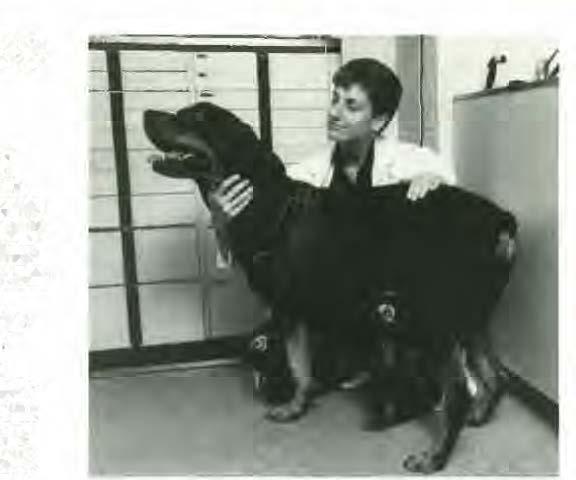
Dr. Weinstein proposes lO use the two drugs concurrently, administering therapeutic doses of cisplatin and slightly lower doses of adriamycin to fur1her slow down metastatic tumor growth. Preliminary studieshave shown encouraging results, four dogs 1reated are doing well six to ten months after Lreatment. She proposes to use the drugs postoperatively, beginning two weeks after surgery, in one group of patiems for a total of three cydes, three weeks apan. Inanother groupof patients, the first dose of drugs wm be administered perioperatively, within 14 hours after surgery, followed by two additional treatments three weeks apart. "Studies in humans and rodents have shown that there is rapid growth of metastatic lesions in these species following surgical excision of primary tumors," she srud. "Studies in laboratory animal tumor models show that administration of perioperative chemotherapy prevents a rapidgrowth phase in metastatic lesions following removalofthe primary tumor.'' Dr. Wdnstein explained that perioperative chemotherapy is not routinely administered to humans with the disease due to fear of postoperative surgical wound complications, such as infections and delayed wound healing. "Our previous results administering pre-, perioperative and postoperative adriamycin to dogs with osteosarcoma do not support high wound complication rates. We hope to document improved survival rates for patients treated with perioperative chemotheupy; this woul.d advance canine osteosarcoma treatment and might also encourage similar studies in human patients with the disease.''
Osteosarcoma in people is adisease of teenagers and young adults. In dogs it affects primarily middle-aged animaJs, though it does occur in dogs under two years of age and in elderly dogs. Canine osteosarcoma may serve as a model for human osteosarcoma and Dr. Weinstein is collaborating with researchers at the Medical SchooJ on several projects. "We are looking at MRL images of the amputated canine limb to establish how the tumor margins seen on the image correspond to the tumor margins established by histological examination." she explained. "lt is very difficult for the surgeon, when doing limb-sparing surgery on people or dogs, to know eJCact!y where the lumor ends," she said. "We hope to determine jusl how accurate the MRI scan is In defining the tumor margins." The studies also encompass a look at the role ofgrowth factors and their receptors in canine osteosarcoma. The role
of P-glycoprotein in the resistance of canine osteosarcoma to chemotherapy will be investigated. The researchers hope to expand the project so that theycan evaluate differentclinical protocols in dogs with osteosarcoma and assess prognostic indicators and chemosensitivityassays to predict differences in the response to treatment.
nr. Weinstein is currently searching for funding for the chemotherapy study from private sources or foundations to support the costs of the drugs. Without support, surgery and the chemotherapy drugs cost about $2,000 per patient. Ifsupport can be found, Lhese costs to the clients will decrease considerably. Dr. Weinstein is also looking for candidates for the treatment and she hopes that veterinarians with canine osteosarcoma patients will refer them to the Veterinary Hospital of the University of Pennsylvania.
Dr. Weinstein graduated from the University of Pennsylvania School of Veterinary Medicinein 1983; she completed a surgery residency at Tufts University School of VeterinaryMedicine and Angell Memorial Animal Hospital; and be.came an instructor in surgery at Tufts. She completed a research fellowship at Massachusetts Genefal Hospital where she worked in the laboratory of Dr. Henry Mankin. a pioneering researcher in bone cancer in people.
Merck Supports Laboratory Animal Medicine Training
Merck Sharp & Dohme Research Laboratories
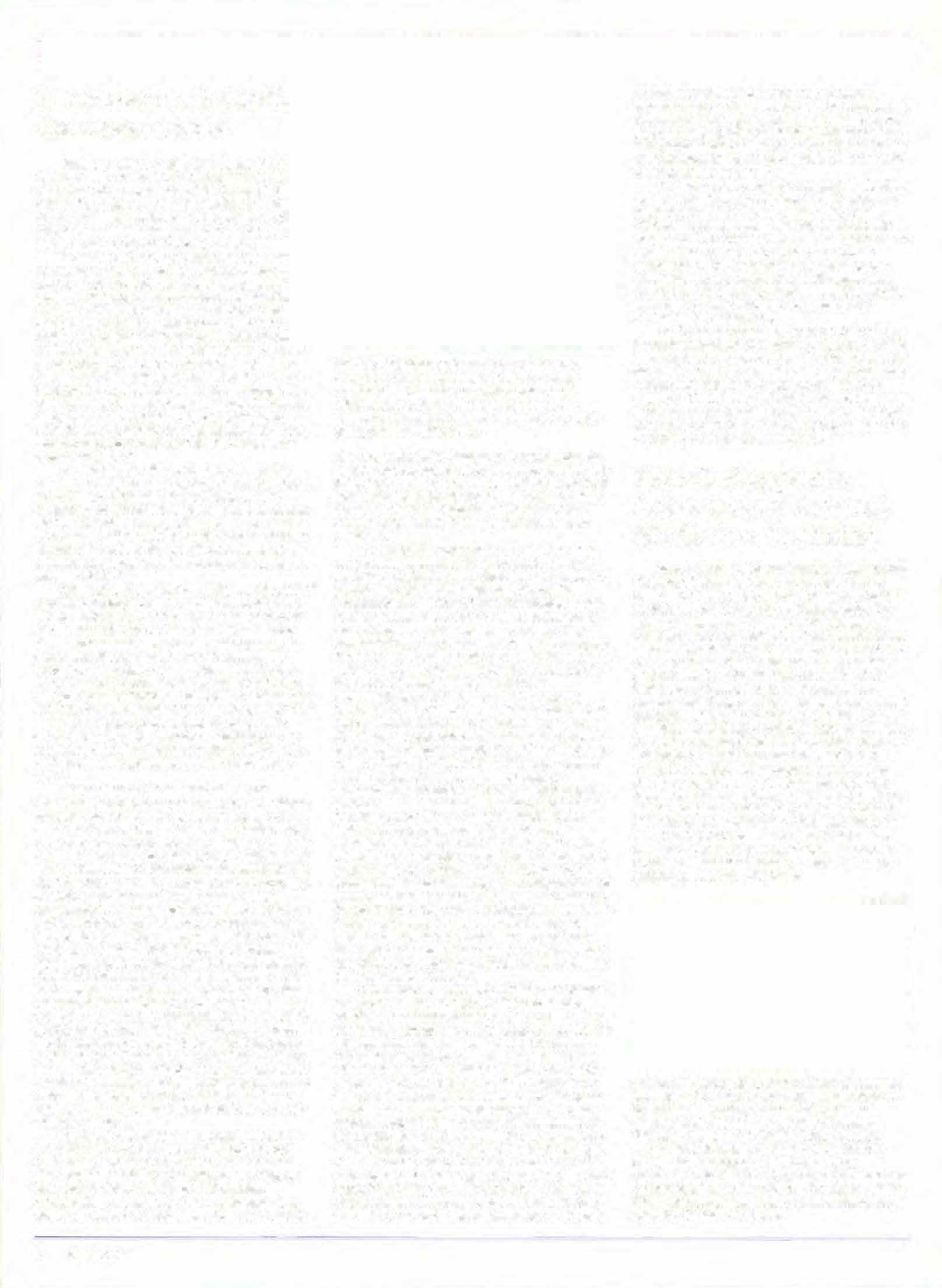
Djvision of Merck & Co., Inc. has provided a postdoctoral fellowship grant h1 Laboratory Animal Medicine at the Universi1y of Pennsylvania. Dr. Laurence Handt, a 1987 veterinary graduate of Mi�.:higan State University, has been selected as the first recipient of the grant and is now in the first year of the program. The laboratory animal medicine program has been in existence since 1987 at the University of Pennsylvania. It is a three-year program combining a residency in laboratory animal medicine with a master's degree in a related scientific discipline. Individuals enrolled in this program also complete a one-month rotation in c he Department of Laboratory Animal Resources at Merck's West Point, PA facility. This program is designed to develop competence in biomedical research and laboratory animal medicine, and prepare candidates for the American College of Laboratory Animal Medicine board certification. This joint effort of Merck and the University of Pennsylvania is an example of the growing trend of the business sector providing financial assistance to foster advanced training in scientific disciplines.
Shown here (leftto rigbt) are Dr. Harry Rozmiarek, directorof t.he University of Pennsyl\'aniaOffice of University Laboratory Animal Resources and director ot the Laboratory Animal Medicine Training Program, Or. Jeffrey Linn, associate dirertor and clinical coordinator, Dr. Laurence Handt, Or. Gwendolyn McCormick, staff veterinarian with Merck's Department of Laboratory Animal Resources at West Point, PA and Dr. Hilton Klein, director of Laboratory Animal Resources, MSORL Division of Merck.

� Bellwether
Feed Costs continuedfrom page 1.

Dr. Galligan for morethan a year. He has a ration sheet and feeds each cow individually according to her production. The rations formulated for his farm savehjm about $400 to $500 a month. Dr. Galligan visits the fam1 perjodically to check and to revise the feeding program and to dis<'uss other berd related problems that might arise.
The interactive computer program has five subunjls: 1. a nutrient requirement section; 2. a feed bank section that stores nutrient composition of available feed; 3. a computational section where rations are evaluated or formulated; 4. a feeding recipe section, which displays or prints grain mix, mineral mix, total mixed ration, or stancl1ion barn recommendations; and 5. a comparative economk evaluator, which ranks feeds by a nutritional cost and benefits algorithm.
"We can select up to 12 fixed feed ingredients from a bank of up 10 100 feeds," explained Dr. Galligan. ''Thebasisofselection is farm availability and nutrient constraints. Selected variable ingreclients are used to balance the ration for dry matter, net energy, crude protein, bypass protein, soluble protein, acid detergent fiber, and neutral detergent fiber. Calcium and phosphorus are balanced using a combination of mineral sources. Trace mineral mixes may be either custom formulated or selected from a bank of proprie1ary supplements on the basis of limited traceelementsin the ration."
The spreadsheet allows individual calculations for the various components. ''We can determine whal kind ofhayto feed ifsoymeal is high in price," said Dr. Galligan. "Ifsoymeal is lowin price, then it. will make up a greater part of the ration and the
Animal Models corainuedfrom page 5 scientists can now screen for the efficacy of some potentialdrugs usingthetissueofone animal rather than using hundreds of animals.
Relinement refers to efforts to reduce pain and distress experienced by lab animals. New guidelines from the USDA and NIH are calling for closer scrutiny by researchers in this area, and are encouraging them to investigate additional avenues to measure and reduce pain for animals.
According to Dr. AJan Goldberg, head of the Center for Alternatives to Anjmal Testing at The John Hopkjns University, the Three R's represent the "common definition of alternatives.'' He said alternative methods in specific cases are scientifically useful, provide a cleaner and more precise result than animal models, and are more economkal.
Thesuccess ofalternatives can be measured by thesurgeintheiruse, Dr. Goldbergsaid. "Tenyears ago chere were few tissue culture areas in research facilities. Now, every facility that bullds a building adds a tissue culture area."
Alternatives most commonly considered arecell, tissue and organ cultures, computer modeling and the use of minimally invasjve procedures that produce lessstress, Dr. Goldberg noted. White more toxicological research isbeing conducted in vitro, the potentiaJ ofculture method in tox.icological protocols and hazard assessment is only beginning to be used and evaluated, he said.
Dr. Goldberg attributed the increase of alternatives to public pressure from the animal protectionmovement. "They'vebeen responsible for encouraging the scientific understanding and development alternatives," he said. "But if the science hadn't beenthere, it never would havecome about ••
Reprinted with permission from "Portraits ofa PartnershipForLife: The RemarkableStory ofResearch, Animals & Man. " Published by the Foundation for Biomedical Research through agrant/rom CTBA-GEIGY Pharmaceuticals.
fanner can use first-cutting hay which does not have that great a mmient value. However, if soy meat is expensive, then we reduce it in the ration formula and recommend that high quality hay be used." This kind of ration formulation requires Lbat farmers change their habits. It used to be that hay was fed in reverse orderofharvesting, meaning that the lastcut bay was fed first. Now Dr. Galligan recommends that the cuttings be storedseparatelyso the haycan be accurately matched totheother feed ingredients to provide the proper nutrition for the least price.
Other food ingredients are also determined by market prices. If one kind of fiber is high priced, then anoiher may be selected. Further, Dr. Ferguson and Dr. Galligan have encouraged farmers to buy feed in bulk, perhaps as a group. Shotzberger purchases minerals and other feed ingredientsjointly with other producers also enrolled in the Production Medicine Services, obtaining a bulk price. Stoltzfus and his neighbor roo combine their orders to get a better purchase price. Stoltzfus has taken an addhional step to reduce his feed costs, he has installed a diesel-drivenroller mill which allows him to mix and prepare his grainmixes. He estimates that this equipment saves him an additional $280 a month.
Drs. Galligan and Ferguson and theircolleagues are continually refining theprogram and the service format. ''We are looking at inventory control systemsand aremakingcalculationsas to whetherit is advantageous to buy a three months• supply, versus a sjx weeks' supply when considering the interest the money could eam if invested alternatively." If all this sounds a bit farfetched coming from veterinarians, it reaUy is not as the contemporaryveterinarian has moved beyond being a mere healer. '�We have to look at the total farm
Welcome
Each Juty VHUP and the Widener Hospital welcome new residents and interns. The new residents at New Bolton are: Dr. Julie Anderson (surgery), Dr. Tony Mogg (medicine), Dr. Pam Wilkins (medicine), Dr. Suad Terzich (poultry pathology). Dr. Rochen Love has joined the Widener Hospital as junior surgery clinician. Dr. Fairfield Baio has been appointed lecturer in cardiology.
The new interns at VHUP are: Dr. Lynn E. Babbitt, V'91 , Dr. Elizabeth Berger, MN'91, Dr. Lori W. Cabell, TN'9l, Dr. Lillian E. Ouda, V'90, Dr. Monika Griot-Wenk, Zurich '89, Dr. Kirk A. Hassinger, V'90, Dr. Richard Ian Hawonh, Cambridge '9�, Dr. CtareKnowler, Glasgow '91, Dr. Nancy Sander, OH '91, Dr. Elaine J. Tobias, V'91, Dr. Susan Westmoreland, V'91. The new VHUP residents are: Dr. Mark Jamba and Dr. Michelle Sabol-Jooes, laboratory animal medicine; Dr. Jean Marie Swingle Greek, WI'90, dermatology; Dr. Mary Wilkes, V'91, anesthesia; Dr. Michael G. Conzemuis, IA'90, orthopedicsurgery; Dr. Richard A. Rockar, V'88, soft tissue surgery; Dr. Derek Hughes, Liverpool '90, emergency medicine; Dr. Joan Regan, V'79, radiology; Dr. Jamie Anderson, CA-Davis '89, Dr. Mark Elie, MJ'85, Dr. Patricia G. Walters, V'90, medicine; Dr. Margaret L. Casals, Zurich '84, mectical genetks.
Dr. Ray Boston, formerly at the Urtiversity of Murdoch, Australia, bas joined the Center for Animal Health and Productivity as professor of applied biomathematics. Dr. Daniel Brockman has joined Clinical Studies, Philadelphia, as lecturer jn soft tissue surgery. Dr. Andrew Wood from the University of Sydney, Australia, is here as visiting professor of radiology.
Welcome to all!
picture," said Galligan. "Whiledisease preventionis an important part of herd health, management practices also significantly contribute co thecost. The veterinarian can take a look at the overall picture and then advise the cliem. By increasing the feed efficiency and advising the farmer about ration formulation we can save him more money tban through many traditional veterinary services."
The members of theCenter for Animal Health and Productivity have been spreading this word at bovine practitioner'smeetingsand now about 1.000 veterinarians use the program to advise their clients. It costs $100, this includes the spreadsheet, a tutorial and a user's manual as well as a year's subscription to the University's on-line bulletin board. Here users find out about updates and improved features ofthe program.
The program is also an import.ant teachingtool for Penn's veterinary students, famiHarizing them with feed rations and formulation of the most economic rationwHhoutsacrificing productionyield.
And what is in thefuture? "WewiH be looking at the futures market to see if feed expenses can be reduced further," said Dr. Galligan. "We are employing economicprinciples and models long used in industry and are applying them to agriculture to help the dairy farmer to remair1 profitable."
Dr. Galligan is an associate professor in animal health economics andholdsan MBA degree from the Wharton School, Dr. Ferguson is an assistant professor in nulrition and is board certified in nutrition and reproduction. The ration formulation program was chosen by LotusMagazineas one ofthe five best applications of Lotus 123 for 1990. The research to developthe programwas funded in part by the Pennsylvania Department of Agriculture.
Promotions and Appointments
Dr. Meryl Littman was promoted to associate professor of medicine; she is chief, Section of Medicine at VHUP. The following were promoted to assistant professors: Dr. Betsy Dayrell-Hart in neurology; Dr. LesleyKingin medicine; Dr. Richard Squires in medicine. Dr. Gert Niebauer was reappointed assistant professor in surgery and Dr. KevinShanley was reappointed assistanl professor in dermatology. Dr. CharlesPughjoined the radiology department in Philadelphia as assistant professor. Dr. Bennett Hershfeld was appointed research assistant professor of ophthalmology.
At New Bolton Center, Dr. Eric Tulleners was promoted to associateprofessorofsurgery and Dr. David Galligan was promoted toassociate professor of animal health economics. Dr. Corinne Sweeney was promoted to associate professor of medicine. The followingwere promoted to assistant professor: Dr. Sue McDonnell to research assistant professor in reproduction; Dr. BenMartinto assistant professor of equine sports medicine; Dr. Patricia Sertich to assistant professor of reproduction; Dr. Ray Sweeney to assistant professor of medicine; Dr. Wendy Vaala to assistant professor of medicine/ neonatology.
Dr. Alan Ruggleshas been appointed lecturer in surgery; Dr. Kim Olsonhas been appointed lecturer in anesthesia, and Dr. JeffRubin has been appointed lecturer in Field Service and Reproduction. Mary Lou Shea has been appointed Director of Nursing at New Bolton Center.
Summer/Fall 1991
ons
Dr. Ray Sweeney, V'82, assistant professor of medicine, received the 1991 Lindback Award for Distingl.Jished Teaching, the University's most prestigious teaching award.
Dr. Roberl Kenney, professor of animal reproduction, istheeighth recipientoftheDavid E. BartlettAward.Thisaward, sponsoredjointlybythe Society for Theriogenology and the American CollegeofTheriogenologists,honorsadistinguished theriogenologist who has made important contributionstothefield.Theawardwaspresented attheannualconferenceoftheorganizations,held in August inSanDiego.Dr. KenneydeliveredtheDavid E.BartlettHonoraryAddress,entitled "Thirty-seven Years Workingwith Cattle, Horses and Other Creatures. What do the Next Thirty-seven Hold?"
Dr. Gary Raiczik, V'84, was named Veterinarian of the Year by The Jersey Shore Veterinary Medical Association for his outstanding contributions to veterinary medicine. Dr. Raiczik served as president of the organization for the pasl threeyearsandheisapartnerintheOceanCounty Veterinary Hospital, Lakewood. NJ.
The second edition of DomesticAnimal Behavior,abookby Dr. Katherine Albro, V'63, bas beenpublished by the Iowa State University Press. Vr. Nbro is director of the animal behavior clinic and professor of physiology at the New York State College(')[VeterinaryMedicine.CornellUniversity.
Dr. Urs Giger, associate professor ofmedicine and medical genetics, and Dr. Colin E. Harvey, professor of surgery, were the speakers at the 13th Annual Robert H. Winn Foundation Dinner and Symposium on Feline Health, held ln June in Philadelphia. Dr. Giger's study, Genetics of Feline BloodGroupsintheUnitedStates.aprojectfunded by the foundation, had its funding renewed. The foundation also funded a new study, Survey of Patella Luxation and Hip Dysplasia in Cats, conductedbyDr. Giger, Dr. PamelaGreen, resident in radiology, and Dr. Gail Smith, V'74, assistant professor of orthopedic surgery. Or. Han-ey also received funding for a study, Location and Concenlration of lmmuno-reactiveCells in the Oropharynx of the Cat, the co�investigator is Dr. Richard Dubielzig, University of Wisconsin. A secondprojectby Dr. Han-ey andDr.StuartCarter, University ofLiverpool, Cluonic Gingivitis StomatitisinCats-Involvement ifMucosalImmune Response, was also funded by the foundation.
Dr. Giger received the John A. Connaughton/ MerieUen Dunston Award from Lhe Cal Fanciers' Association of America for outstanding service to catsandthecatfancyattheirannualmeetinginNew York.
Barry Stopiue,associatedean foradministration and director of VHUP. is serving as acting vice president forhumanresourcesattheUniversity. He divides his time between the School and the University.
Or. Harold M. Smith, V'4J, hasbeenappointed bythe executive board of the American Veterinary MedicalAssociationtotheAVMAAnimalWelfare Committee, representing private equine clinical practice. Dr. Smith is an honor roll member of the AVMA and the AAEP.
Dr. Jill Beech, associateprofessorofmedicine, receivedfundingfromtheAmericanQuarterHorse Association for her work on hyperkalemia periodic paralysis.
Dr. Robert Bckroade, associate professor of poultry pathology, testified at hearingsof theNew York Department of Agriculture on behalfof the Pennsylvania Poultry Federation. Dr. Eckroade reviewed the unresolved scientific issues regarding Salmonella enteritidis and the logistical problem of testing large numbers of poultry houses.
Dr. Donald Abt, V'61, presented a lecture, AquacultureintheU.S. -Whereis itGoing?,atthe New York Fanners dinner in New York.
Dr. Robert S. Hoge, V'SS, was awarded the 1991CharlesE. BildPractitioneroftheYearAward bytheAmericanAnimal Hospital Association. Itis thehighestawardgivenbytheassociation. Dr. Hoge was honored for his many contributions to the veterinary profession.

Dr. SCuarC Wiles, V'60, wasfeaturedinPeople Maga-zillein May. Dr. Wiles iscommissioner of laboratory animals for Cambridge, MA.
Dr. Ralpb E. Werner, V'68, received Distinguished Service Awards from the New Jersey Veterinary Medical Association and the Atlantic City Police K-9 unit.
Dr. Harry A. Reynolds, V'56, retiredfromthe UniversityofIllinoisCollegeofVeterinaryMedicine facultyafter 25 years of service.
Dr. David R. Nunamaker, V'68, JacquesJenny ProfessorofOrthopedicSurgery,hasbeenappointed to the Scientific Committee of the Grayson Foundation.
Dr. Dun Richardson, assistant professor of surgery, received a grant from the Grayson Foundation for a study, The Biochemistry and Morphology of Equine Articular Cartilagein DegenerativeJointDiseaseandtheir Relationshipto Subchondral Bone Stiffness. The foundation also awarded a grant to Or. Eric TuUeoers, associate professor of surgery, for his study, Partial Arytenoidectomy in the Horse using an Extra Laryngeal Approach.
Dr. Kenneth Bovee, Corinne R. and Henry Bower Professor of Medicine, Dr. Joan Hendricks, V'79, associate professor of medicine, Dr. Meryl Littman, V'15, associateprofessorofmedicine, Dr. Richard Squires, lect.urer in medicine, and Dr. Sheldon Steinberg, V'S9, professor of neurology, presentedpapersatthemeetingoftheBritishSmall Animal Association in Birmingham, England in April.
Dr. John Simms, V'74, hasbeenappointedfora three-year term to the Small Business/Agriculture Advisory Council of the Federal Reserve Bank of Philadelphia.The 12-membercouncilmeetsregularly with the bank's executives and has as a major goal facilitation of two-way commut1ications between small businesses and the farming industry and the Federal Reserve Bank.
Iowa State University Press publishedPigeon Health andDisease by Dr. David C. Tudor, V'Sl.
Dr. Leslie Dierauf. v•74. has accepted an officialstaffpositionwiththeHouseCommitteeon Merchant Marine and Fisheries.
Dr. Adrian Morrison, professor ofanatomy, has been appointed to thenewly formed editorial boardofthejournal,Sleep,andtotheInternational Advisory Board of the JoumalofSleep Research which is published by the European Sleep Research Society.Heiscurrentlyonleaveofabsencewhilehe

servesasdirector,OfficeofAnimalResearch1ssues, Alcohol, Drug Abuse, and Mental Health Administration (ADAMHA) at NIH.
The School's Center for Animal Health and Producttvity waswellrepresentedatthe 1991 Annual MeetingoftheAmericanDairyScienceAssociation in Logan, UT, in August. Dr. James Ferguson, assistantprofessorofnutrition,deliveredaninvited paper in the Borden, Inc. Symposium on Protein. Twelveabstractswerepresented by Dr. Linda Baker, agraduatesrudent, Dr. William Chalupa, professor of nutrition, Dr. Ferguson, Or. David Galligan, assodateprofessorofanimalhealtheconomics,and Dr. Paul Pilcher, a graduate student. Drs. Baker, Chalupa, FergusonandGaJiigaoalsoparticipatedin the annual meeting oftheAmerican Association of Bovine Practitioners in Orlando, Fl, in September. Thegroupgavethreedifferenttwo-dayseminars for practitioners.
Dr. Kirk N. Gelatt, V'65, received the 1991 GainesCycleFidoAwardthroughtheAVMA"for work in clinical research or basic sciences that has contributedsignificantlytotheadvancementof small animal medicine and surgery.', Dr. Gelatt is consideredapremierresearcherandeducator inthe field of glaucoma.
Dr. Darryl Biery, professor of radiology, and Dr. Mark Saunders, V'81, assistant professor of radiology, presented scientific papers at the Ninth Meeting of the International Veterinary Radiology Association (lYRA), beld in Veldhoven, The Netherlands, in August. Dr. Biery was re-elected lYRA director for North America and appointed chairman ofthe Ol'ganizing committee for the next internationalmeeting. TheTenthlYRAmeetingwill beco-hostedbytheUniversityofPennsylvaniaand the American College of Veterinary Radiology in Philadelphia in the summer of 1994.
Dr. Samuel Chacko, professor of pathology, spentthreeweeksinLeningradinJulyattheUSSR AcademyofScienceInstituteofCytologywherehe did a collaborative study with Russian muscle biologists.HethentraveledtoJerusalemtopresenta paper at the International Biochemistry Congress.
Dr. Virginia Reef, assislant professor of medicine,receivedoneofthe 1991Samuel F. Scheidy Memorial Awards. The awards were established in 1984 by a grant from Smitl1Kiine Beecham to encourage participation in international scientific affairs and to support travel by AVMA-member veterinarians to the World Veterinary Congress.
TheSchoolwaswell representedat themeeting ofthe American College of Veterinary (oternal Medicine in New Orleans in May. Papers were presented by: Or. James Buchanan, professor of cardiology, Dr. llrs Giger, Or, Monika Griot-Wenk, Dr. David H. Krtigbt,professor ofcardiology, Or. Meryl Littman, Dr. Virginia Reif. Dr. Michael Rosenzweig, Dr. Richard Squires, Dt. Corinne Sweeney, associate professor of medicine, Dr. Wendy Vaala, V'80, assistant professor of medjcine/neonatology. and Dr. Robert Washabau. V'82, assistant professor ofmedicine.
Or. Dolores Holle, V'81, wasappointedattendingveterinarjanand directorofcaninehealthmanagement for The Seeing Eye, Inc., Morristown, NJ.
Dr. Karen Overall, V'83, lecturer in behavior, made a presentation to veterinarians and veterinary technicians at the annual meeting of the Morris Animal Foundation in Denver in June.
10 lkllwether
Dr. Mary Beth Callan, Y'88, is the new transfusion medicine fellow.
Dr. Bruce Madew�n. V'70, received a grant fromtheMorrisAnimalFoundationtostudygenetic changesindogswithcancer. Dr. Madewell is withthe University of Califomja School of Veterinary Medicine at Davis.
Dr. Sberbyn Ostrich, V'63, has been elected chairman of the executive board of the AVMA.
Dr. Carla Chieffo, V'86, hasreceivedatwo-year postdoctoral NIH fellowship.
Dean Edwin J. Andrews, V'67, testifiedbefore the Labor, HeaJth and Human Services and Education subcommitteeoftheHouseCommltteeon Appropriations. Dr. Andrews presented veterinary medicine's views concerning programs administered by the National Institutes of Health. Dr. Andrews wasthemoderatorofaprogram,TheCommunication of Animal Welfare and Rights, at the AVMA meetinginSeattle. InJulyheassumedthepresidency ofthe Association of Veterinary Medical Colleges andheservesassecretaryofthe NationalAssociation of StateUniversities and Land Grant Colleges Commissjon on Veterinary Medicine. Or. Andrews chaireda symposium attheXXTVWorldVeterinary Congress in Rio de Janeiro, Brazil, in August, entitled� Veterinary Education in tbe 21st Century. Dr. Andrews accepted an appointment to the ScientillcAdvisoryBoardofBiotechnologyPartners Capital Fund. Jn September he participated in an AVMA Symposium on Public and Corporate Veterinary Practice.
Ziskind Prize Awarded
Joseph Sito, V'93, is the recipient ofthe Dr. MorrisL.ZiskindPrize.Theprizewasestablishedby Dr.Ziskind, V'36, andisawardedtothesecondyear student receiving the highest combined grade in PoultryMedicine,Epidemiology,andPublicHealth.
Scholarships
Lynne Manone, V'93, and Kenneth Tomer, V'92, werenamedthefirstLoisF. FairchildScholars in Veterinary PubJJc Health. John Moore, V'92, received the Westminster Kennel Foundation Scholarship.TheClarkFoundationofCooperstown, NYawardedascholarshipto Joshua Clay, V'95. Six students received educational grants from the American Kennel Club: Gillian R. Gibson, V'94, Amy Hollengreen, V'93, Arthur Jankowski, V'94, Lynne Mazzone, V'93, Susan Volk, V'95, andNoelle Weeks, V'95. Ms. Mazonne also won a scholarship last semester from the Association for Women Veterinarians and she was named a 1991 Regional lams Veterinary Scholarship Award recipient.
The New Jersey Veterinary Education Foundation awarded scholarship grants to Pamela Beodock, V'92, Tiffany Bogart, V'92, Mary Lou Ciccone, V'92, .lobo Price, Y'93, Robin PuUeo, V'92, and Kenneth Turner, V'92. Ms. Bendockalso receiveda scholarship from theUnionCountyK.C. Sharon Lacbeue, V'92, is the recipient ofa scholarship from the Mid-Susquehanna K.C. The LancasterK.C.awardedscholarships last semesterto Julie A. Norton, V'91, Frederick M. Rock, V'91, and Lisa A. Ruth, V'94.
Patricia M. Hogan, V'92, is lherecipient of a scholarship from the AmlanFoundation. Linda Casper, V'92, Cynthia DiBuono, V'92, Erin Hanoabach, V'92, and Lod Ludwig, V'92, each received a Salsbury scholarship. ,Jay Jasan, V'93, received a scholarship from the Plainfield Animal Hospital. Ann E. lJastian, V'93, received a scholarship from the Meeting House Charter Chapter ofthe American Business Women's Association. Maureen Firth, V'93, was awarded a scholarship by the Maine Rehabilitation Fund Scholarship Committee.
Teaching Awards
The ballroom at the Hotel du Pont in Wilmington was filled to capacity for the Annual Student Government Dinner Dance on April 14. Centerpiece ofthe evening was the presentation of the1991 StudentGovernment AwardsforTeaching Excellence to members of the faculty and staff.
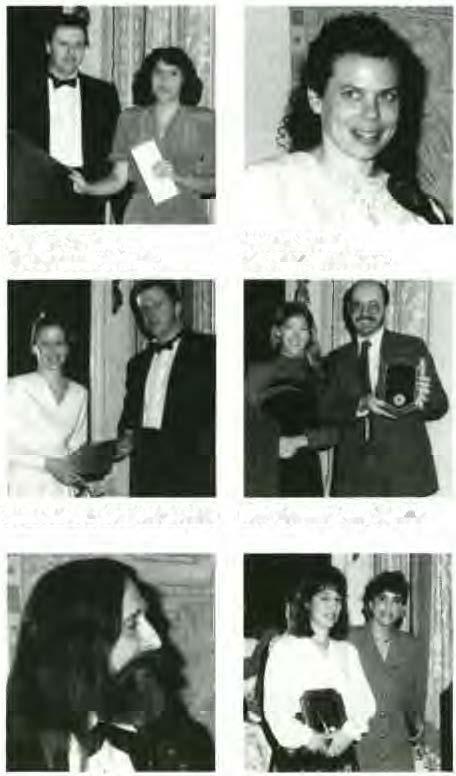
Designed t.o enable each of the four classes of the School to honor an individual who exemplifies the highest degree of proficiency in teaching, the award is given to "anyone involved in the educational process who has made a major contribution to our veterinary education through dedicated, creative, and informative teaching."
Dr. Mark Haskins, associate professor of pathology, was the recipient ofthe Class of 1994 Teaching Award. The Class of 1993- presented its award to Dr. Thomas Van Winkle, assistant professorofpathology. Dr.CharlesReid,professor of radiology, received the Class of 1992 Teaching Award TheClassof1991 presenteditsawardtoDr. Lesley King, lecturerinmedicine.The1991 Student GovernmentTeachingAwardswerealsopresentedto Donna Oakley, head nurse, VHUP; Dr. Beth Ann Brockman, an intern at VHUP; and to Dr. Marjan Govers, a resident at VHUP.
Dr. DeborahM.Gillette,assistantprofessorof pathology, was the recipient of the Norden Faculty Teaching Award Or. John H. Wolfe, assistant professor ofpathology and medical genetics, receivedtheBeechamResearchAward.TheDr. Jules SilverBedsideMannerAwardwaspresentedtoDr. Brockman. Dr. Celeste Boatwright, junior surgery clinician, received The Wmiam B. Boucher Award forOutstandingTeachingatNew BoltonCenterbya House Officer. The Jams Small Aruma! Clinician Awardwaspresented toDr.BethCallan,residentin medicine. The Resident's Award for Outstanding TeachingbyaFacultyMemberwaspresentedtoDr. Robert Washabau, assistant professor ofmedicine.
Theevening was supported by the following benefactors: Hills Pet Products, The Upjohn Company, Veterinary MedicalStudentGovernment, SCAVMA, Peterson Imaging, Inc., and ANAQUEST.
Veterinarians and Wildlife Experts Train Arab Wildlife Rescue Workers
The massive oil spills in thePersian Gulfearly this yearendangered many birds, marine mammals and fish. A United Nations-sponsored six-member team,threeveterinarians,twowildlifespecialistsand abirdspecialist,was broughttoBahraininMayto help train wildlife workers to cope with the great influx of animals injured by the oil. The team was assembled by Tri-State Bird Rescue and Research, Inc. of Wilmington, DE, a group with a strong reputationforsuccessfullyrehabilitatingoiledbirds. Itincluded Dr. Greg Bossart, V'78,theveterinarian at Miami Seaquarium. Dr. Josh Dein, V'80, U.S. FishandWildlifeServiceWildlifeHealthLaboratory (Madison,W1),Dr.VirginiaPierce,V'87,directorof the Laboratory of Pathology, Philadelphia Zoo, Lynne Frink, president, TSBRR,MaryJaneDalton, clinic supervisor at TSBRR. and John Ffinch, assistantcuratorofbirdsatthePhiladelphiaZoo.To provide additional expertise by phone, a multinational Oil Spill Support Team was organized. Its 14 members are experts in such fields as research chemistry, veterinary medicine, wildlife rehabilitation,animal nutrition, wildlifebiologyand fisheries biology and medicine. Three members of that team are School alumnae, Dr. Leslie Oierauf, V'74, Dr. Susan Donoghue, V'76, and Dr. Julia Langenberg, V'82.
The five-day workshop in Bahrain attracted 45 participants from Oman, Qatar, Saudi Arabia, Egypt,and Bahrain. "Wewerethoroughlyimpressed withthelevelofenvironmentalawareness amongthe Arabs, and theenthusiasm with which they approached each topic we presented," said Dr. Pierce. "Wefeelconfidentthattheprogramsthatare developedasaresultoftheworkshopwill bestaffed by competent and enthusiastic nationalswithsome expatriareconsultantsprovidingneededexpertjse,at least in the initial stages.'>
Theworkshopcoveredawidevarietyoftopics, including human health and safety, protection of vulnerable habitats, deterrent methods {to try to prevent birds frombecoming oiled), field retrieval methods, the general characteristics of birds and special notesontbebirdsandvulnerablehabitatof thePersianGulf. Theteamalsoextensivelycovered aspects of medica] and rehabilitative care of oiled animals, necropsy techniques, and how to design, staff,andoperatearehabilitativefacilityduringan oil spill. Dr. Bossartgavedetailedlecturesonthecare andmanagementofoil-injuredseaturtles, dolphins and dugongs. In addition to lectures, the team provided twoafternoon hands-ontrainingsessionsin bird handling, medical evaluation, and necropsy procedures.
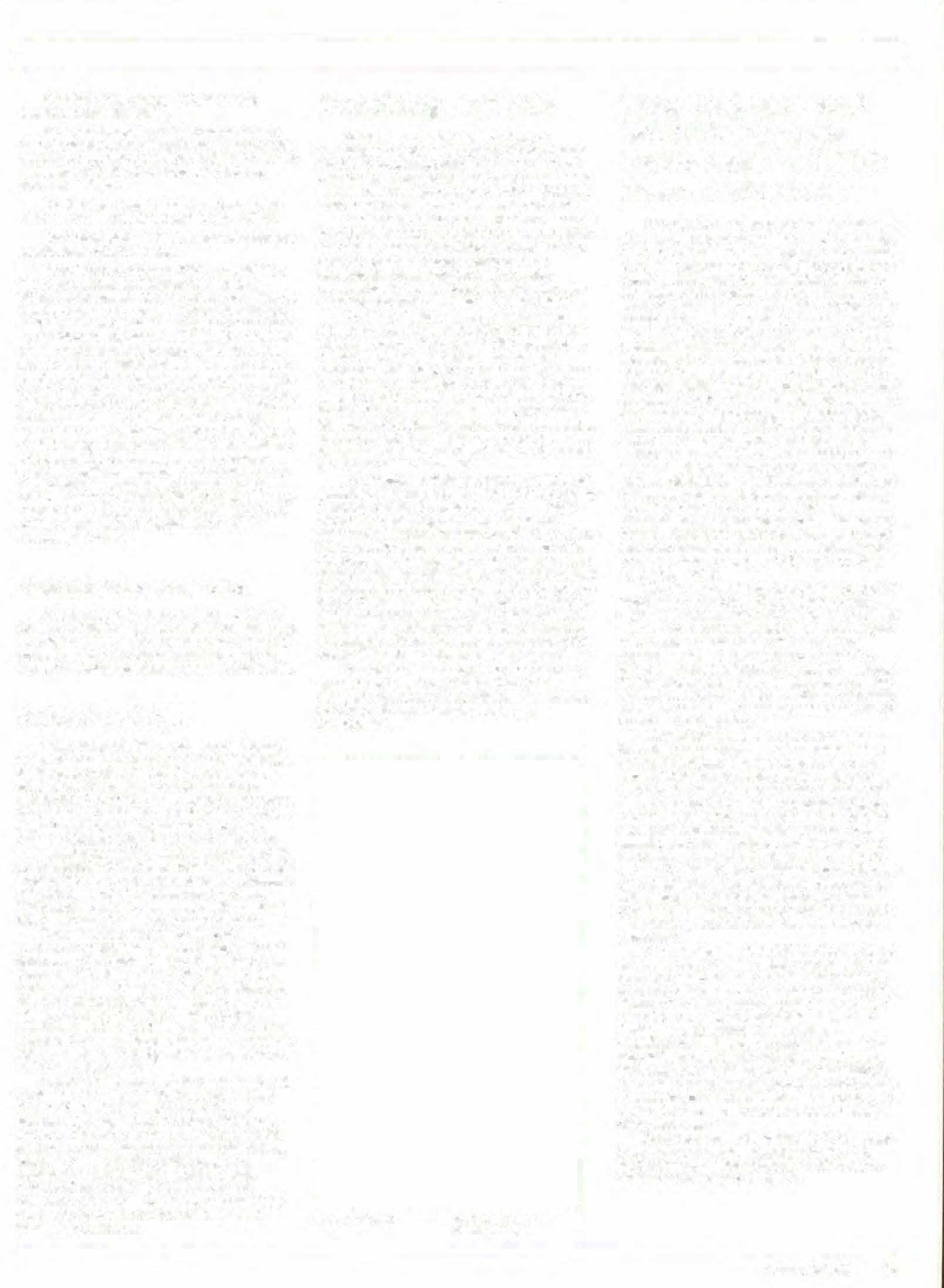
TheteamalsovisitedtheWildlifeRescueCenter in Jubayl, Saudi Arabia, which was established in Januaryinresponsetotheoilspill. ''OnJanuary26 theSaudiswerefacedwithadauntingtask,••saidDr. Pierce. "Oneofthelargestoilspillsonrecordinthe face ofa war, with no established rehabilitation facility, no stafftrained in oiled animal rehabilitation, and having to deal with two of the mostdifficultbirdspecies-cormorantsandgrebes. WithtemporaryassistancefromtheBritishRSPCA andaDutch expertteamsponsoredbytheEuropean Community.thecenterhandled 70 to 100birdsaday during February and managed an approximately 40% release rate."
DuringceremoniesinWashingtonD.C. onJune 5 the team was recognized along with the U.S. Marinesfortheircontributionstotheeffortsofthe Wildlife Rescue Center in Jubayl.
Norden Award, Intern Award, Dr. Deborah Gilletle Or. Beth Brockman
JII.DlS Award. Dr. BethCallan Or. Thomas VBJl Winkle
Or. Mark Haskins Technician Award, Oonna Oakley
Summer/Fall1991 11
Echinococcus
The parasites commonly foundin fecal examinations ofdogs and cats are Roundworms (Ascaris), Whipworms (Trichuris), Tapeworms (Dipylidiumand Taenia) and Coccidia.
Echinococcus multi/ocularis has beenreported in north-central Uruted States and south-central Canada. Foxes and coyotes are the common definitivehosts,butdogsandcats may beinfected. Rodents are the intermediatehosts and become infected by ingesting eggs passed in thefeces. An ]nfected rodent will have hydatidcysts jn the liver. When a canideatstherodent,adultwormsdevelop in llle intestinal tract. The adult tapeworm is too small to berecognizedinfecalsamples.but the eggs appear the same asthose of Taenia.
Humans may become infected with the intermediate stage but very few cases have been reported. High-risk groups include hunters and wild-life biologists. Prevention against hand-tomouthtransferofeggsfromcontaminatedobjectsor areas is importanL
Highlyeffectivedrugsareavailabletotreatdogs and cats infected with adult worms. Diagnosis is a problem because of theextremelysmall size of the wormandtheneedtodifferentiatetheeggsfromthe common Taenia. Surgery is preferred treatment for hydatid disease when it has been diagnosed in humans but chemotherapy may be considered.
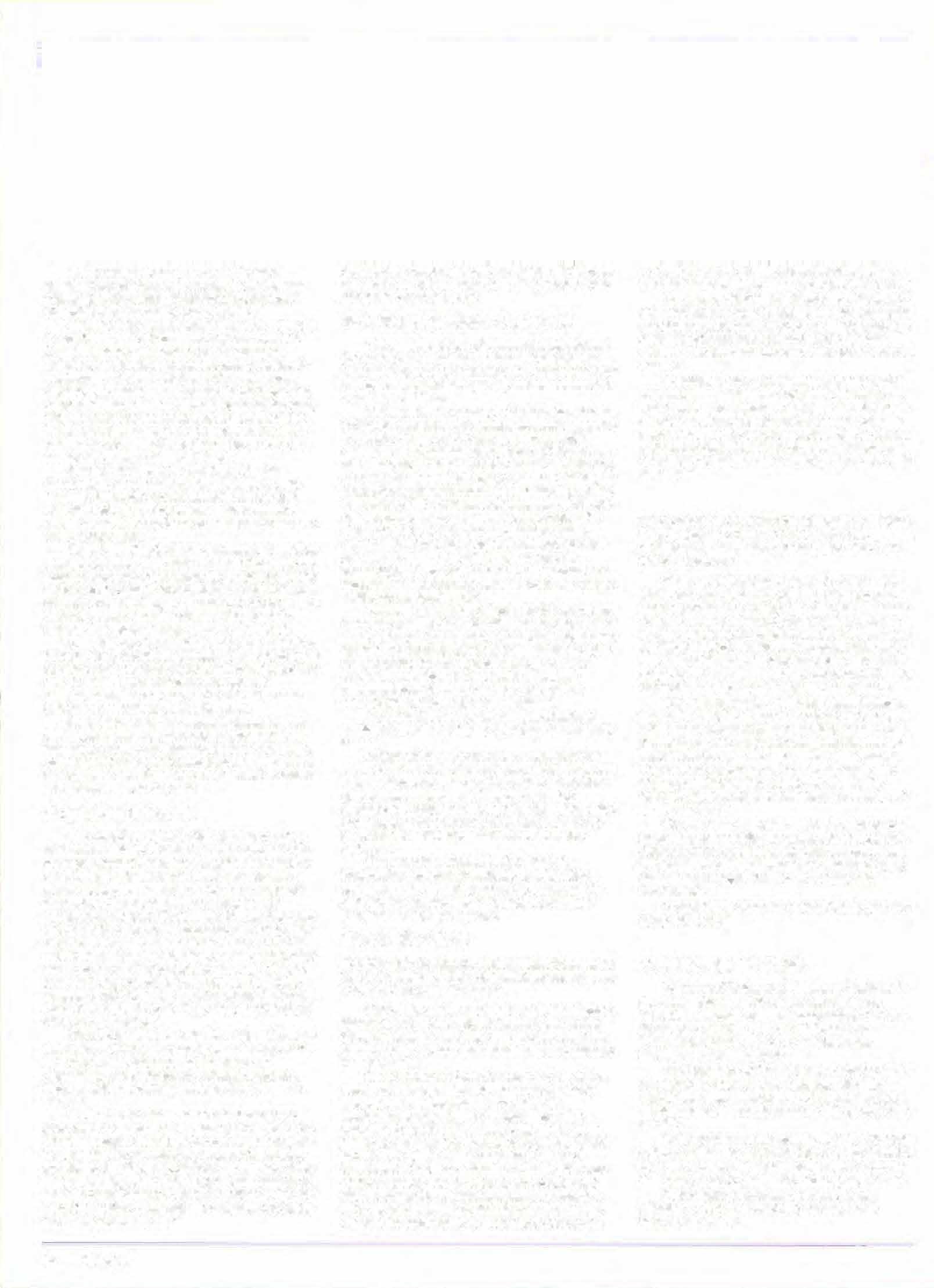
Zoonoses arediseasesthatcan be transmittedto humans fromvertebrate animals. Your veterinarian cantellyouifyouareina region where Echinococcus may be found. Infected dogs and cats are asymptomatic bur because of the risk of human infection, precautionsshouldbe taken.
Roundworms are anextremely important and widespread public health problem. Viscera/larva migransis a diseaseofchildrencausedbyeating dirt contaminated with embryonatedascarideggspassed by dogs and cats. Treatment for ascarids in ldttens and puppies should be routine.
Popular Breeds
The American Kennel Club reports the "top ten"breedsregisteredin 1990. Cockerspanielswere the most popular breed for the eighthconsecutive year, followed by Labrador retrievers, poodles, golden retrievers, Rottweilers, Germanshepherd dogs, chow chows, dachshunds, beagles and miniature schnauzers. The bottomfiverankings were otterhounds, American foxhounds, Sussex spaniels, English foxhounds, and harriers. There are other registries, so these low rankings do not mean these are "rarebreeds. ·• The AKC registered 1,253,214 individual dogs in 1990. The petit basset griffon Vendeen (PBGV) wasthe!31stbreedadmitted to the AKC Stud "'Boolc in 1990. Theywere in 97th place with 354 registrations.
Th�Cat Fanciers Association registered 34,961 catsin 1990.ThePersian was byfarat the top of the list . followed by Siamese, Maine coon cat. Abyssinian, exoticshortbair, oriental shorthair, Scottish fold, Burmese, American shorthair, and Birman.

ln theUnited States, there are about seven governingbodieslocal shows andregistries, the CFA beingthelargest.Standardsforsomebreeds may not berecognizedbyallregistries.Atmostshowsthere areclasses for ''Household Pets." These are either longhairor sborthair and a breed name cannot be usedforthemTabbyis a color,so"tabbycat"isnot abreedorvariety,althoughsomedictionaries define it as "any domestic cat!'
It is estimated S9 million cats in indicatethatthedogandcatpopulationwillincrease by about one million each year. It is obvious that purebreds are a minority.
Pet Population Control
Theoverpopulationof unwanted dogsandcats is a serious and complex problem. Considerable guesswork is used is estimating the number of dogs andcatseuthanizedeachyearbyanimalshelters.but it is in the millions.
The American VeterinaryMedical Association (AVMA) recognizes that animal population control is a major concern. The first priorityisstrict enforcement ofanimal control laws. (Thlsincludes fmes imposed on dogs allowed toroam and licensing laws that favor neutered pets.) Substantially higher licensefeearerecommendedforanimals that are not neutered. AVMA recommendslicensing ofallcats and control measures forthem comparable with those fordogs. lt alsohas an intensive public education/information programdesigned to make pet owners moreresponsibleand concerned. Neutering is highly recommendedanditshouldbea requirement that animalsadopted from any animal shelterbe rendered sterile
The most promising solution to the control of unwantedanimalsliesintheultimatedevelopmentof aneffectiveandinexpensive,nonsurgicalsterilization method foranimals. Surgical sterilizationis highly recommended but theseprocedures provide an ineffectivesolution to the control ofanimal overpopulation. Surgery must be used until a nonsurgical methodhas been developed.
An identification system for petanimals is needed toaid in identifying unwanted orunowned animals.
Irresponsible pet owners are responsible for most of the surplusdogs and cats. Whendogs and catsareaUowedto run free,theyaddtothenumber of lost animals and contributeto unwanted pregnancies. Oftenownerslose interest whena dog grows up pastthecuteandcuddlystage.Dogsmay beabandoned to shelters because ofbehavior problems.
The American Kennel Club's Limited Registrationprogram is basically non-breeding agreement-anyoffspringcannot be registered. We still need an enforceable ''Planned Parenthood Program" for allpet owners.
Book Review
SUPERCAT-RaisingthePerfectFelineCompanion by Dr. Michael W. Fox. Howell Book House, New York, NY $l9.95, Hardcover.
Thisbook,withitsmostinterestingillustrations, shows that catsare inteltlgenl (sapient) and sentient (have feelings). It explores ways to raise and train catsproperly,evaluate their intelligenceandenhance theirpotentials.
Somestatementsfromthe text -' 'Catssenda variety ofmessages through unmistakable body language The household eat's abilityto manipulate humans has be perfected over the centuries. ln mostcases, whena cat wants to be picked upandpetted,itisgoingtobepickedupand petted! . . A cat's facial expression will vary considerably based on changing stimuli - themost obvious changes can be seen in ear position and dilationofpupils.. Rubbingagainstapersonisa eat'swayofshowingaffectionforahuman.Italso allowsit lhe opportunitytoscentmarkthatperson.
It is universallyaccepted thatpurringis asign of felinecontentment-(othercatsoundsaredescribed). ... A eat's senseofsmellisguesstimatedasbeinga hundredthousandtimesmoreprofoundthanours.''
Thethreecriticalfactors in raisinga"supercat" aresocialization, early handling and environmental enrichment....Kittensthatgrowuptogether provide social enrichment and companionship for one another.Theidealsituationistoraiseone of eachsex together.
Longhaired cats were developedbymanandso require human assistancewith their grooming ... Thequestionofwhetherornot pet cats should be allowed outdoors will alwaysbe argued. Givinga tomcat access totheoutdoorsexposeshim to disease and danger and allows him to father numerous unwantedkittensandkill a variety of birds and small animals."
OLDDOGS,OLDFRIENDS.EnjoyingYourOlder Dog by Bonnie Wilcox, D.V.M. and Chris Walkowicz. Howell Book House, New York, NY. $22.50 Hardcover
Dogsareliving longer today. A recent study shows that after weaning (infancy is thegreatest dangerperiod), the average life span has increased from 5.1years to 8.7 years.Afterthefirstbirthday, thelife expectancy is twelve years. The Guiness Book ofWorld Records (1990)listsan Australian cattle dog named Dluey as holding the record forcanine longeviry, at twenty-nineyears, five months. Bluey worked as astock dog fornearly twenty years!
Theopening words · "Old dogs, like old shoes, arecomfortable. Tbey may be a bitoutofshapeand a littlewomaroundtheedges,buttheyfit well. Old friends know andaccept our idiosyncrasies and our imperfections. Andold dogs are the best friends. Theynotonlyaccept usasweare,theydon'toffer adviceorcriticism. The elderly pet makes few demandsuponusandisusuallyhappytosimplycurl up by our feet."
Thebookhasnumerousanecdotes,stressesthe importanceofprovidingforanimalsinemergencies, discussesrescueoperations,hasinformationoncare andtreatmentof the problemsand diseases ofaging and has an excellentchapter on dealing with bereavement.
Ifyottt dog is amemberofyourfamily,youwill enjoy this book.
V.M.D. or D.V.M.
Thereare 27 CollegesofVeterinaryMedicinein the United States which are accredited bythe American Veterinary Medical Association . Of these, 26 award a D.V.M. Only t.he University of Pennsylvania grants a V.M.D. (Veterinariae MedicinaeDoctoris) degree.
The University of Pennsylvaniagraduatescanbe recognized by their degree. Through 1991, the V.M.D. has been awardedto4,702graduates (I,01t women and3,691 men),beginning with thefirstclass in 1887.
To be grammaticaUycorrect, if <�or." isused beforea name, the academic degreeis not included afterthe surname. It should be Dr. John Doe, or John Doe. V.M.D., never Dr. John Doe, V.M.D. Veterinarian is a noun, veterinary is an adjective. There is a veterinary school, not a veterinarian schooL
12 DeUwetber
Legislators' Day 1991

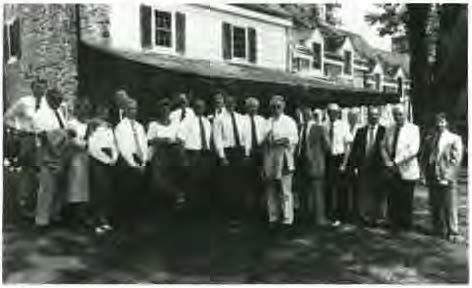
Veterinary and Comparative Pathology Symposium
Dr.MichaelGoldschmidt,associateprofessorof pathology, organized the 15thAnnual Symposium onVeterinaryand Comparative Pathology, held in June at the Marine BiologyLaboratory in Woods, MA.TheprogramwascosponsoredbytheSchool's Department ofPathobiology and the Continuing Education Division ofthe C.L. Davis D.V.M. Foundation. Inadditionto Dr. Goldschmidt, the followingPennfacultymembersmadepresentations: Dr. Gustavo Aguirre, professor ofophthalmology; Dr. Robert Bullis, research associatein microbiology;Dr.MarkHaskins,associateprofessor of pathology;Dr. Mattie Hendrick, assistant professorofpathology;Dr.AlanKelly,professorof pathology;Dr.TomVanWinkle,asisstantprofessor ofpathology; and Dr. John Wolfe, assistant professorofpathology and medical genetics.
Dr.
WilliamMedway
Honored
Atthe1991AnnualMeetingoftheInternational AssociationforAquaticAnimalMedicine(IAAAM) heldin Marineland, Florida from May 12through 16, Dr. William Medwaywas designated an Honorary Life Member for his manycontributions onbehalfoftheassociationandthefieldofaquatic animal medicine. Dr. Medway, Professor Emeritus of Clinical Laboratory Medicine, is only the fourth member of the association to be so honored He is bothafoundingmemberandapastpresidentofthe IAAAM.

Canine Symposium
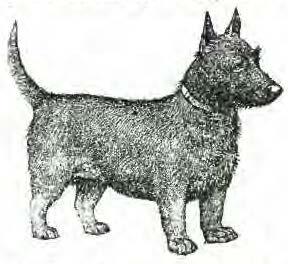
TheTwenty-second annual symposium, Your VeterinarianandYourDogs, will be held on Saturday, January 25, 1992at the Veterinary Hospital ofthe University of Pennsylvaniain Philadelphia. Theday-longeventwillconsistoffour presentations:
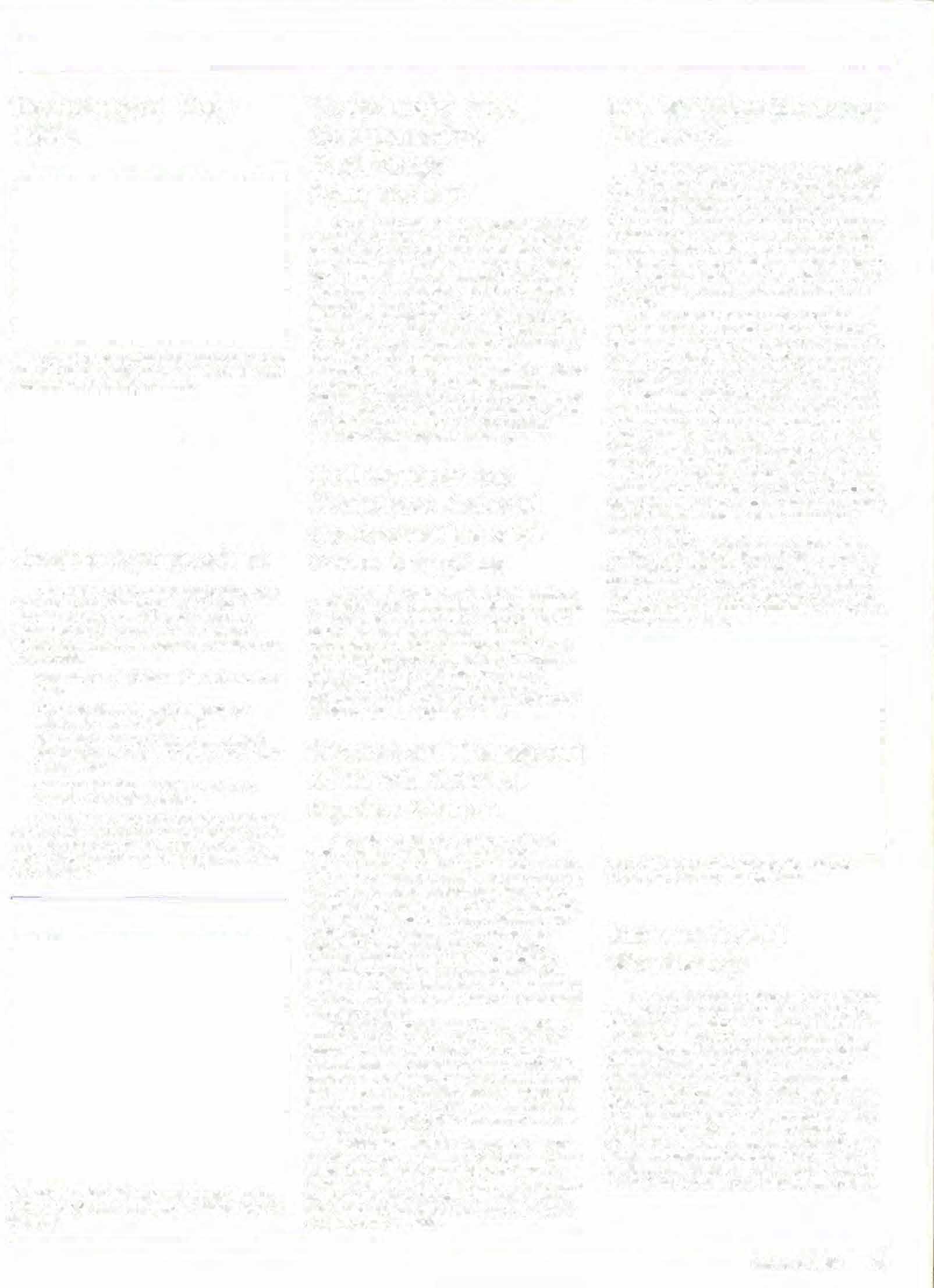
Vaccinations:TheGoodandtheBad-Dr.Peter Jezyk
Diagnostic Screening andPrevention of Heartworm - Dr. David Knight
Diagnosis ofAllergic Diseases and Clinical ManifestationsofThyroidDisease-Dr.Robert Schwartzman
Common Parasites ofCanines and Their Control - Dr. ThomasNolan.
Thecostof theprogram, including lunch and parking,is$45.Reservationsarerequiredandcanbe made by contacting Dr. M. Josephine Deubler, VHUP,3850SpruceStreet.Philadelphia,PA19104 (215) 898-8862.
Colloquium on Domestic Animal Cytogenetics and Gene Mapping
The Seventh North American Colloquium on Domestic Animal Cytogenetics and Gene Mapping was held atthe School in July. Organized byDr. RichardA. McFeely, professorofanimal reproduction, the colloquium was attended byan internationalgroupofcytogeneticists.Dr.RalphL. Brinster, Richard King Mellon Professor of Reproductive Physiology, andDr. Donald F. Patterson,CharlotteNewtonSheppardProfessorof Medicine, each led a plenary session.
Course on Transport of Fresh Cooled Equine Semen
A oneday seminaron Transport ofFiesh Cooled Stallion Semen willbeoffered to veterinarians and farm managers on November 22, 1991 at the Georgia and Philip Hofmann Research Center for AnimalReproduction at New Bolton Center.thelargeanimalfacilityoftheUniversityof Pennsylvania School of Veterinary Medicine. The course. taught bymembers ofthe Section of Reproduction, will encompass the veterinary, technical, and business aspects of developing a successful program fortransporting fresh cooled equine semen. Both stallion and maremanagement willbecoveredinthemorninglecturesandafternoon laboratory sessions.
Equinefreshcooledsemenhasbeenusedfora number ofyearsin the breeding ofperformance horses. Now that the United States Trotting Associationhasallowedthistechniqueforthe 1992 breedingseason,itisimportantforveterinariansand farmmanagerstobefamiliarwiththemanagement techniquesrequiredforutilizingfreshcooledequine semeninabreedingprogram Theseminarwillcover allaspects oftheprocess.
Enrollmentislimitedto50people.Thefeefor thecourseis$325perpersonand$225 peradditional person from the same organization or farm. For further information and registration, pleasecontact the Section of Reproduction, New Bolton Center, 382 WestStreet Road, Kennett Square, PA 19348. (215) 444-5800,ext. 2222.
The announcement was made during the conferencebanquetandtooktheformofa''roast" byformerstudentsrepresentingtheentirespanofhis career on the faculty ofthe Veterinary School.His "oldest"student,DonaldA.AbtV'6l,initiatedthe "roast"andthenturnedthemicrophoneovertothe otherconferenceparticipantsgatheredtopaytribute toDr.Medway.TheywereJohnC."Ray"Sweeney V'7l, J. Lawrence Dunn V'73, Leslie A. Dierauf V'74, Richard H. Lambertsen V'79, Paul P. Calle V'83,RobertW. UlbrichV'86,GregoryA.Lewbart V'88,HowardN.KrumV'92andRoyP.E.Yanong V'92. A whale sculpture suitably engraved is being preparedforDr.Medway.Naturally,heofferedan appropriaterebuttaltohisformerstudentswhenthey had finishedtheir versions of his teaching and research career.
Dr. Medway presentlyservesas one ofnine members ofthe MarineMammal Commission's CommitteeofScientificAdvisors, acommittee of scientistsstatutorilyrequiredtobeknowledgeablein marine ecology and marine mammal affairs-, who advisetheMarineMammalCommissiononpertinent marinemammalissues.
International Workshop
The First International Workshop on Erection and Ejaculation in Horses and Men was held in SeptemberatNewBoltonCenter.OrganizedbyDr. SueMcDonnell, research assistantprofessor of reproduction, and fundedbythe Dorothy Russell Havemeyer Foundation, this is the first ofan expected series ofworkshops on erection and ejaculation.Thepurposeoftheinitialmeetingwasto gatheraninterdisciplinarycoreoftentotwelvebasic andclinicalandrologistsworkingonerectionand/or ejaculation for review of current knowledge, consideration offuturecomparative research, and planningofcontinuedinteraction.Theparticipating physiciansandveterinarianscamenotonlyfromthe United States butalso fromGermanyand Poland.
A group of Pennsylvania legislators visited New Bolton Center in May for tours of the facility and presentations by faculty members.
Mr. and Mrs. Jack Billhardt and Martha Rogers, V'92, one of the tbreeMrs. Jack L. Blllhardt Dean's Scholars.
From left to right: Dr. Medway. Dr. Abt, Dr. Ulbrich, Dr. Sweeney and Dr. Dunn.
Summer/FaU1991 13
Alumni Day 1991

Alumni Day 1991 was a family affair with a clownforthe youngsters, carriage and hayrides, and a side saddle riding demonstration by Mrs. Jack Bregman and Mrs. John Rotelli, Jr. Morethan 200 people attended the event at New Bolton Center.
In the morning the official business of the Veterinary Medical Alumni Society was conducted and the Alumni Awards ofMeritwere presented. Dr. MichaelRatner, V'59, passedthegaveJ ofofficeof president to Dr. Jack Bregman, V' 66, and introduced the officers and members of the board. They are:
Dr. Jack Bregman, V'66, President
Dr. Daniel D. Bleicher, V'53, President-Elect and Vice Chair, Liaison Commiuee
Dr. Michael P. Rattner, V'59, Past Presidem and Chair, Awards andNominating Committees


Members-at-Laree
Dr. Macolm Borthwick, Jr., V'69
Dr. Pierre A. Conti, V'60
Dr. Richard Derstine, V'57
Dr. Diane R. Eigner, V'80, Benjamin Franklin Society Chair and Phonatlwn Co-Chair
Dr. John R.S. Fisher. V'61
Dr. George L. Hartenstein IV, V'68, Liaison-NBC
Dr Seth A. Koch, V'65, Annual Giving Co-Chair andPhonathon Co-Chair
Dr. Edgar R. Marookian, V'54
Dr. Sidney L. Mellman, V'49
Dr. Pat A. Picone, V'78, Annual Giving Co-Chair and Phonathon Co-Chair
Dr. Donald R. Shields, V'63
Dr. Joseph D. Slick, V'53, Chair, Pennsylvania Veterinary Medical Historical Society

Dr. Steven W. Syken, V'86
Dr. Robert J. Tashjian, V'56
Dr. Alexandra Wetherill , V'80
Other Board Mem�rs
Dr. M. Josephine Deubler, V'38, Historian
Dr. Darryl Biery, FacultyRepresentative
Dr. Charles Benson, Faculty Representative
Dr. Kathy M. Mockler, V'90, Pacesetter Represemadve
Dr. Michael Moyer, V'90, PacesetrerRepresentative Student Representatives
Meredith Brown, V'93
Roy Yanong, V'92
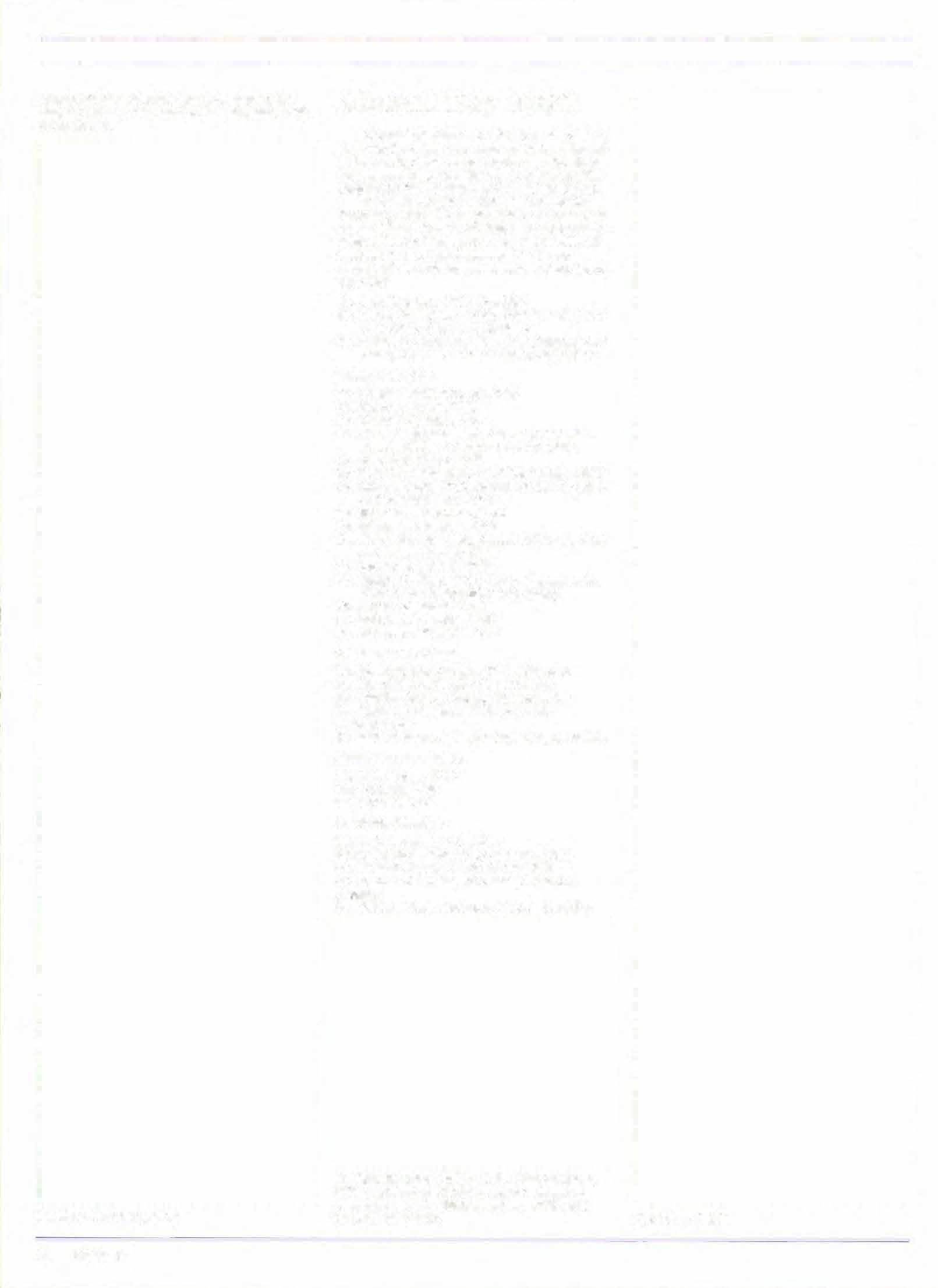
Steve Cudia, V'94
Ex-Officio Members
Edwin J. Andrews, V'67, Dean
Nancy Martino, Director ofAlumniAffairs
Dr. Bruce E. llgen, P.V.M.A. President
Dr. Martha O'Rourke, New Jersey V.M.A. President
Dr. William Wade, Delaware
V.M.A. Presidem
Alumni Awards of Merit were presented by Dr. Michael Ratner, V'59, and Dr. Jack Bregman, V'66, to six alumni.
Or. Roy D. Hoffman, V'31
Dr. Edwin A. Churchill, V'41
Dr. Jay Simmons, V'56
Ur. Elizabeth Atwood Lawrence, V'S6
Dr. Donald Abt, V'61
14
I>r. Marc Rosenberg, V'71
BeUwether
�. . • I .• ' ''· . . .. • ' • ' � \ f � > • .. ".
Or. Max Herman, V'59, and Dr. Jack Bregman, V'66, president of VMAS, presenc a plaque of appreciation to Dr. Michael Ratner, V'59. past president of VMAS.
The Clas of 1941
The Class of 1946
The Class of 1951
The Class of 1956
The Class of 1961
Tbe Class of 1966
The Class of 1981
Commencement
The Commencement Exercises for the l06th graduating class took place May 21, 1991 at the Zellerbach Theatre. Thecommencement address was given by Professor Lord Soulsby.
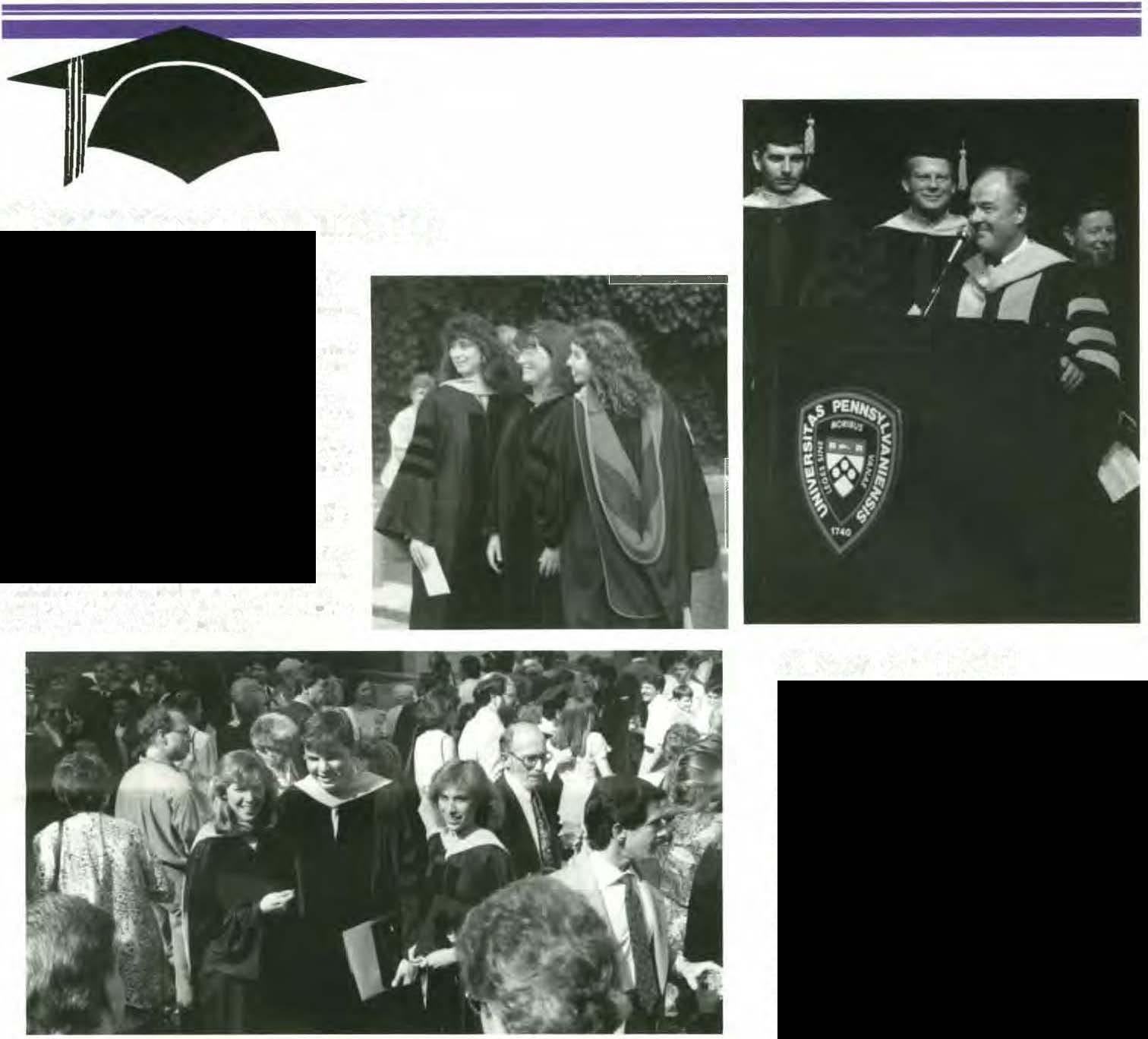
Dean Edwin J. Andrews, assisted by Assistant Dean Jeffrey A. Wortman, V'69, Associate Dean Charles D. Newton, and Mr. Charles S. Wolf, chairman, Veterinary School Board of Overseers, presented the djplomas to the 103 members of the Class of 1991. Class President Janice M. DeRiso presented comments and Dr. Jack Bregman, V'66, president of the Veterinary Medical Alumni Society, presented the class flag lo Dr. DeRiso. Dean Andrews, assisted by Dr. Raymond W. Sweeney, V'82, presented awards and prizes tograduatesand recognized those graduating with honors.
The administration of the Veterinarian's Oath by Dr. Bruce llgen, president of the Pennsylvania Veterinary Medical Association, concluded the ceremony. Everyone then gathered for a reception for the graduates and their families.
Award Recipients
Leonard Pearson Prize
Susan Valerie Westmoreland
J.B. Lippincott Prize
Susan Bayard Schoen
1930 Class Prize in Surgery
Lisa Marie Miller
Auxiliarytoth�American VeterinaryMedicalAssociation
Prl:.e
Janice Madeline DeRiso
Auxiliary to thePennsylvania Veterinary Medical Association Prize
Kirk Theodore Smith
1956 Class MedalforAchievement in Paihofogy
Ruth Sullivan
James Hazlltt Jones Pri"t;e in Biochemistry

Lee Anne Myers Palmer
American AnimalHospiiolAssociation Award
Derek Scott Duval
Merck Awards
SmallAnimalAward
Andrea Jean fascetti
Large AnlmalAward
Joanne Wampler Raudenbush
George M. Palmer Prize
Laura Nichols
Class of 1991
Samantha Gail Abbott
Sarah ShaferAlcorn*"
Jennifer Ann Andres n•
Rita Angelo ..
Paul Raymond Avery u
Lyon Ellen Babbilt
Barrie Michele Barr
Lori Lei Bason
Jean Marie Betkowski••
Mark Leonard Boccella
Christopher John Bonar
Rebecca Boncheck
Mary MagdaJena Bowser
Katherine Standish Bradley
Elaine Judith Brott-Tobias
Elizabeth Ann Campbell
Gregg William Campbell
Christopher Keith Cebra •+
Kenneth Klevan Cullen
Natalie Nero Daniels
Georgine Kathryn Danyl
Janice Madeline DeRiso
Nancy Kate Diehl
Derek Scott Duval
Michael Evan Dym
Everifrgham Prizefor Cardiology
Jean Marie Betkowski
E.L. Stubbs Award in Avian Medicine
Carol lynn Yeisley
Large Animal Surgery Prize
Samantha Gail Abbott
LorgeAnimalMedicine Pn'ze
James Seddons Holt
MorrisL. Ziskind Prize in SwineMedicine
Robert John Lewis, Jr.
Morris L. Ziskind Prh.e in PublicHealth
Raquel Maria Walton
Phi Zeta Award
Ruth Sullivan
Hill'sAwordforNutrition
Julia Ann Norton
Purina Mills Awardin SwineMedicine
Robert John Lewis, Jr.
Upjohn Awards
SmallAnimal Award
Lisa Marie Miller
LargeAnimalAward
James Seddons Holt
Auxiliary to the Student Chapter oftheAmerican Veterinary Medical Association Prile
Mark Jerome Pykett
Gregory Edwin Erdman
Gregory John Ertz
Sandra Jean Fargher
Andrea Jean Fascetti
Katherine Ann Ferlan
Caryn Finegan
Cindy Ellen Fishman
Rosemary DrewGanser
Eileen Marie Geagan
Andrew Neale Gormllll
Amy L. Grausam
James Seddons Holt • •
Scort David Joho�on
Janet GraceJones
Michele Marie Karpovch
Cynthia Ann Kerr
Marilyn Sillon Khoury
Joyce Ruth Koch
Margaret Nell Lackey
Debra Ann Lane
Dena Christine Lebo
Maria Litchfield Lewis
Robert John Lewis. Jr.
Stephen Keith Long
Thomas John LyoM
Heather Kate Mack
Lisa Ann Macom
Paul M. Marcus
Maureen Ann McElhinny
Jarni Kay McGregor
Michael Lawrence Mihlfried
Lisa Marie Miller
Sally Fuller Mobraaten
Jaime Freddy Modiano
Diane Lynn Monsein *
Judith Ellen Sklar Nabomy
Shelby Jean Neely
Laura Nichols •
JuliaAnn Norton
lois Elizabeth Palin
Lee Anne Myers Palmer u•
Jennifer Lyle Platt
Mark Jerome Pykett •••
James Stephen Quartuccio
Joanne WamplerRaudenbush*_.
Robynlec Reichard
William Peterson Rives
Frederick Martin Rock
Mark Louis Roma
Susan Bayard Schoen ...
Cathy Marie Schweingruber
Joellen Shaw
Kenneth Thomas Shiarella
Lindsay Scott Schreiber
Matthew Wade Singer
Sean David Smarick
Kirk Theodore Smith �...
Bernadette Spector
Susan Marie Spilker
Heidi Byers Stout
Ruth Sullivan •
Lisa Perri Suslak
Clair D. Thompson II
Kenneth Page Trippett
Barbara Lynn Vail
MaryBernadetteVanKooy•
Donna Lynn Vittorelli
Nancy Jean Voytosb
Raquel Maria Walton "
Kimberly Ann Werner
Susan Valerie Westmoreland
Mary Elizabeth Wilkes
Rex Brian Woo-Ming •
DonnaLeeWoodwonhNameyu•
Mark Kevin Wyno
Carol Lynn Yeisley
Le�lie Ellen Ziemer
Stan Michael Zuczek
... Summa Cum Laude .. Magna Cum Laude '" Cum laude Summer/Fall
1991 IS
Bellwether 31
Bellwetherispublishedby theSchool of Veterinary Medicineat the University o!Pennsylvania.
Edltt>r: lllustrator:
Helma Weeks Mari� Gara[ano
Writers: Photograpllers:
Dr. M. Josephine Adam Gordon
Deubler(AnimalCrack�r$)Lynne R. Klunder
Phyllis Holtzman Anthony Wood
Jan Kangilaski
Susan Perfojj New BoltonLiaison:
Helma Weeks 0)therlneLarmore
We'd like to hear your praise, criticisms or comments. Pleas.eaddress Yow G'OI'respondenc:eto:
Helm11 Weeks, University ofPennsylvania. School of Vererinary Medicine. 3800Spruce Street, Phtladelpllfa, PA !9104-6010 (215)898-1475. Noneofthesearticlesaretobereproduadin any form withOut th�permssion oftheeditorsof Bellwether_ 1991 Copyrightbytile Trustees of the UniversityofPennsylvania.
VHUP News
The OncologyClinic, under thedirection ofDr. Jerry Waddle, sees new cases Mondays and Wednesdays.
The Canine Hip Clinic is held Tuesdays, 5 to 7:30p.m. Clients can make appointments bycalling 898-4680.
The Dermatology Departmentis now offering skin serologytestingforcanineallergies. Aserumsampleis needed and should be submitted to Dr. Robert Schwaru.man's immunology laboratory at VHUP.
Bellwether 31
University of Pennsylvania
School of Veterinary Medicine
3800 Spruce Street
Philadelphia, PA 19104-6008
Address correction requested
Continuing Education Courses for Practitioners
October 23, 1991
Small Animal Medical Problem Solving, Part I
Dr. Joan Hendricks, Associate Professorof Medicine
Dr.LesleyG. King,AssistamProfessorofMedicine
Dr. Alan R. Klag. Resident in Medicine
Dr. Meryl P. Littman, Associate Professor of Medicine
Dr. RichardA. Squires. Assistant Professor of Medicine
Dr. Robert J. Washabau, Assistant Professor of Medicine
This programwill illustrate lbe use of tbe problemsolving method in small animal clinical practice. A case discussion format will be utilized in solving every-day practice problems, including;
1. Tackling the Problem of Proteinuria
2. The Coughing Dog
3. Managing the Vomiting Dog
4. Hemolytic Anemia
5. Urinary Incontinence jn the Dog
6. The Ascitic Dog: What to do
The case discussion will emphasize diagnosis and therapy of these common practice problems.
Sunday, November 10, 1991
Clinical Hematology in Small Animals•
Presented by Veterinary Transfusion Medicine
Acadeillic Awardees, organized by Dr. Urs Giger.
Dr. W. Jean Dodds - Coagulopathies
Dr. Kenneth Meyers - von Willebrands Disease
Dr. Joseph Smith - Iron deficiency anemia
Dr. Urs Giger- Erythropoietin and its clinical use
Dr. Susan Cotter- Autoimmune hemolytic anemia
Dr. Robert W. Bull - Patemity resting in small animals
Dr. Susan Cotter -Emergency hematology
Thisone-dayprogram provides a unique opportunity to learn from nationally recognized veterinary clinical hematologists. Each speaker will present a stale-of-the-art review and the latest information about clinical signs, laboratory tests, and management of common hematologic disorders in small animals. Ms. Donna Oakley will demonstrate VHUP's blood transfusion program and the first veterinary bloodmobile.
This course is partially supported by Baxter General Health Care, Biopure Corporation, and Cin-Med Association.
*In PennVetter the datefor this coursewaslistedat November 20, pleasenotecorrect date of November 10.


To register for CEcourses, please contact Ashra Markowitz, Office ofContinuingEducation, School of Veterinary Medicine, University of Pennsylvania, 3800 Spruce Street, Philadelphia, PA

I.
Printedon recydedpaper.
Nonprofit Organization US Postage PAID Philadelphia, PA Permit No. 2563












































